 Walks and other things
Walks and other things
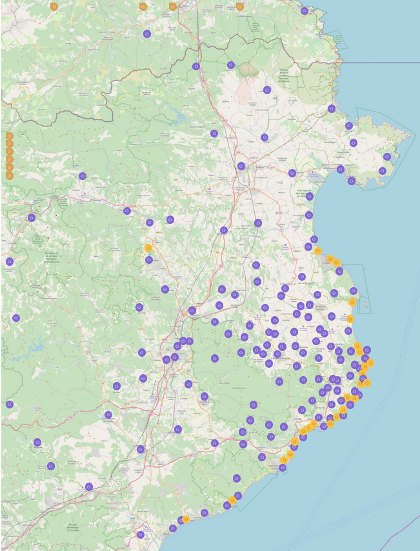 One of the joys of the Costa Brava is the variety of landscapes and we like to visit places and walk (a lot), particularly into and around the Gavarres. Sometimes we travel around on bike. In the summer, we swim and canoe.
One of the joys of the Costa Brava is the variety of landscapes and we like to visit places and walk (a lot), particularly into and around the Gavarres. Sometimes we travel around on bike. In the summer, we swim and canoe.
These then are write ups of walks, hikes and activities that we've done since November 2012, with photos straight from the original walk or activity.
We like to make circular walks and our walks range in length from about 4km (an hour) to around 16km (four hours) - but probably about 2 1/2 hours on average - though if you want to reduce the length, there are usually shortcuts.
To find walks by location, click on the map, which goes to a full sized map with links to individual walks and visits. To our surprise, we were listed in the Sunday Times' Essential Costa Brava (Feb 2017).
The most visited walks are:
- Calella de Palafrugell/Cap Roig to Castell - classic wild Costa Brava
- Far de Sant Sebastia (Llafranc) to Tamariu
- Platja d'Aro and S'Agaro
- Sa Tuna, Cap de Begur, Begur
- Eulogy to the Ruta del Tren Petit (Palafrugell, Palamos, Mont-ras and Vall-llobrega)
- Fornells and Aiguablava walk (GR92)
- Mont-ras to Calella de Palafrugell and Llafranc
- Platja de Castell and La Fosca
- St Antoni de Calonge, Torre Valentina to Platja d'Aro (almost)
- Escala, St Marti d'Empuries and beyond
- Bell-lloc and Castell de Vila-Roma (Palamos)
- Platja Sant Pol to Sant Feliu de Guixols
- Roses - Canyelles beaches to Cap Falconera
- Blanes, Lloret de Mar, Tossa de Mar by GR92
Arbucies autumn walk
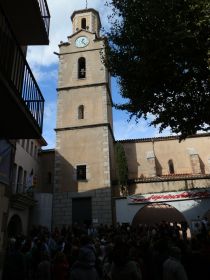 Tardor (Autumn in Catalan) and Montseny beckons. The leaves are just turning colour, there are chestnuts to be collected and the days are bright and clear. Montseny is the grand mountain that sits between Barcelona and Girona, rising to 1700m it's tall enough to see snow during winter, but its great defining quality for us, is that it is full of paths, streams and deciduous woods - sycamore, beech, oak. The ideal place to stomp through fallen leaves. It's about sixty minutes drive from the Costa Brava so really quite close, but it's a different landscape and almost feels like a different climate.
Tardor (Autumn in Catalan) and Montseny beckons. The leaves are just turning colour, there are chestnuts to be collected and the days are bright and clear. Montseny is the grand mountain that sits between Barcelona and Girona, rising to 1700m it's tall enough to see snow during winter, but its great defining quality for us, is that it is full of paths, streams and deciduous woods - sycamore, beech, oak. The ideal place to stomp through fallen leaves. It's about sixty minutes drive from the Costa Brava so really quite close, but it's a different landscape and almost feels like a different climate.
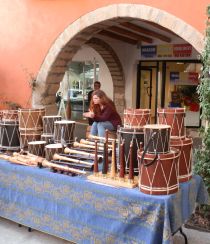 We're walking on spec plucking Arbucies out of the air as we've never visited before. In other years we'd visit Sant Hilari de Secalm or Sant Coloma de Farners. We don't have a planned route as such and our ICC maps at 50,000:1 aren't particularly good for walking so we're hoping to find some paths and signposts to begin with.
We're walking on spec plucking Arbucies out of the air as we've never visited before. In other years we'd visit Sant Hilari de Secalm or Sant Coloma de Farners. We don't have a planned route as such and our ICC maps at 50,000:1 aren't particularly good for walking so we're hoping to find some paths and signposts to begin with.
For the drive we travel up from Hostalric - a walled town with a castle that is easily overlooked but woth visiting. The route takes us past the castle at Castell de Montsoriu which we've visited before and is definitely recommended. It's a castle which stands at 600m high on an isolated hilltop and easily seen from the AP7 if you're driving from Barcelona to Girona. It has fabulous views from the top and a good collection of legends and stories associated with it.
As we arrive in Arbucies the giants are out - it's the Festa de Flabiol - a small Catalan wind instrument - and market day meaning the car parks are full. We part close to the Aigua Aguda bottling factory - people are collecting water from the public spring on the other side of the road - something quite common where the water has a good reputation.
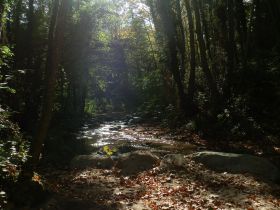 As we walk past the spring we notice steps up the hillside and take the path up. The area looks like it was once a park, but water erosion has washed out many lights and path barriers, but it's a fun diversion into the woods. Back on the road we head into the centre past the craft market stalls and into the centre where there's a stall selling drums and pipes. The town has gathered in the main square underneath and independence flag and an orchestra of pipers with drums wearing Barratines, the long red catalan cap starts to play. They're playing the Flabiol with one hand and the drum, slung from their shoulders, with the other and it's extremely good for two one-handed instruments.
As we walk past the spring we notice steps up the hillside and take the path up. The area looks like it was once a park, but water erosion has washed out many lights and path barriers, but it's a fun diversion into the woods. Back on the road we head into the centre past the craft market stalls and into the centre where there's a stall selling drums and pipes. The town has gathered in the main square underneath and independence flag and an orchestra of pipers with drums wearing Barratines, the long red catalan cap starts to play. They're playing the Flabiol with one hand and the drum, slung from their shoulders, with the other and it's extremely good for two one-handed instruments.
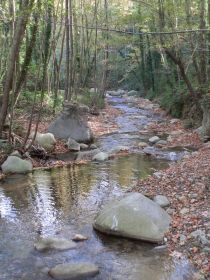 After the music finishes we continue through the town, a mix of older buildings almost suggesting a grander history and typical Spanish apartment blocks. We walk out along the direction of the river. As we're following the road we notice a park below the road to the right and head down into the fallen leaves, following a canalised small feeder stream above the height of the main river below. As we continue the feeder stream meets the lower river and we have to jump across rocks to cross the river to a park on the other hand. Three out of the five of us got wet feet (four out of six if you count our dog).
After the music finishes we continue through the town, a mix of older buildings almost suggesting a grander history and typical Spanish apartment blocks. We walk out along the direction of the river. As we're following the road we notice a park below the road to the right and head down into the fallen leaves, following a canalised small feeder stream above the height of the main river below. As we continue the feeder stream meets the lower river and we have to jump across rocks to cross the river to a park on the other hand. Three out of the five of us got wet feet (four out of six if you count our dog).
The river runs through the valley with a children's play ground on one side and there are lots of families out walking with young children. It's probably because it's that type of day, the autumn sun is scattering through the leaves of the trees and sparkling on the river water flowing in the valley. Underfoot is dry and scrunchy and the woods feel like they are just enjoying the day.
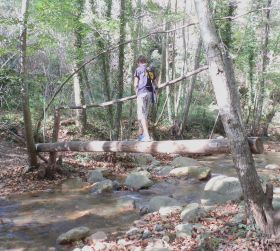 We follow the river crossing once and then twice on small bridges, throwing stones into a mill pool by a tumbledown factory mill, its walls down to about a quarter of their original height. As we follow the river we disturb a grass snake sunbathing on the path. It seems to wake up and slides quickly away into the undergrowth.
We follow the river crossing once and then twice on small bridges, throwing stones into a mill pool by a tumbledown factory mill, its walls down to about a quarter of their original height. As we follow the river we disturb a grass snake sunbathing on the path. It seems to wake up and slides quickly away into the undergrowth.
The path crosses a tributary and to get to the other side of the river we have to take a makeshift bridge that has been made from a log supported by two trees with a handrail nailed above it. Eventually we start to worry we're heading too far out. The next crossing is a road bridge - little more than a gravel track above some concrete pipes. There are signposts and we turn up the hill and away from the river.
 At the top of the path we come to a masia with wide eaves - almost in a Swiss way where the eaves would be used to keep the snow off the path. We follow their track out only to find a cami particular sign at the end - it wasn't marked that way from the bottom.
At the top of the path we come to a masia with wide eaves - almost in a Swiss way where the eaves would be used to keep the snow off the path. We follow their track out only to find a cami particular sign at the end - it wasn't marked that way from the bottom.
At this point we have an option straight on into the woods, or left and back to Arbucies. We take a chance and head upwards into the woods, and keep going on and on and on. After a while we realise that we're not getting over the hill and we seem to be getting more and more into the woods. Unfortunately on the map we have it's not clear enough to see exactly where we are. We decide to go down to the previous junction, and then continue down and into the town. It's lunchtime now and the town is empty apart from the craft market stalls. The man selling fuet and salamis has his eyes closed and is sleeping at the stall. A little further down, children are doing handstands in the middle of the road. We continue back thoroughly refreshed for the evening.
Nearby: Palafolls castle - Hostalric stroll - Lake at Sils - Castell de Montsoriu - Santa Coloma de Farners - Brunyola - Visit to Roda de Ter and Espinelves - Bonmati and Anglès
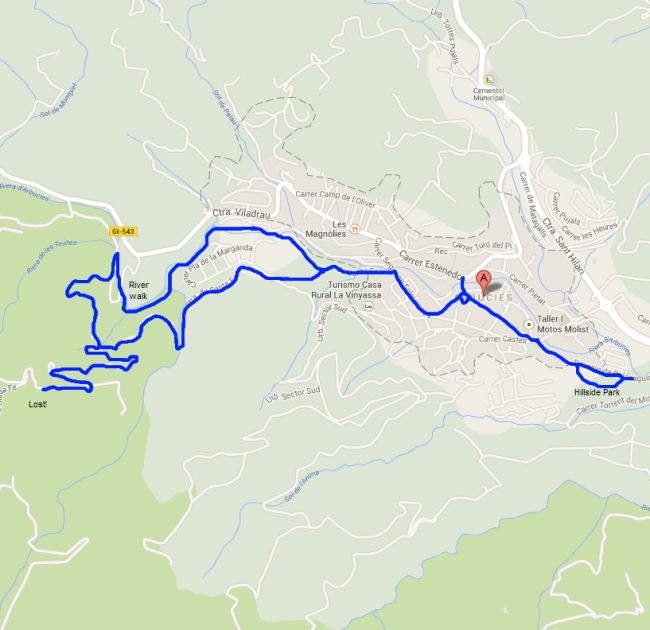
Colomers and Jafre
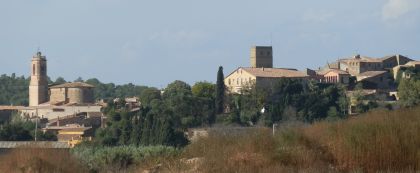 Colomers and Jafre are small villages that sit along the river Ter just to the west of Verges, so a little off the beaten track. The main reason you might visit Colomers is to hire a kayak from the canoe centre and gently paddle along the languid undeveloped Ter to Verges where the canoe centre will pick you up - a great alternative day out to the seaside. Alternatively you might come to Colomers for the ballooning centre next door.
Colomers and Jafre are small villages that sit along the river Ter just to the west of Verges, so a little off the beaten track. The main reason you might visit Colomers is to hire a kayak from the canoe centre and gently paddle along the languid undeveloped Ter to Verges where the canoe centre will pick you up - a great alternative day out to the seaside. Alternatively you might come to Colomers for the ballooning centre next door.
We're here to see the villages. We've had fun with the canoeing in the past, but didn't stop to look at the village so this time we park at the field by the double-decker London bus that houses the canoeing centre and walk into town. Colomers itself is a typical Empordan walled village rising from a height above the river (in the past the Ter would have flooded badly) to a church, a tower and then into the hills. The houses are generally being renovated, but there are still a few as yet untouched with the charm of grass growing on the roof and flowers growing out of the walls.
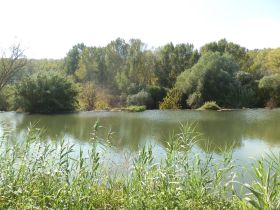 After a brief tour of the village we follow a pebbled path up the outside of the what would have been the old walls to the top of the village and then cut onto a track that takes us into the woods beyond. It's a pine wood with sandy ground under foot and very open and spacious. For October, the day is surprisingly warm - into the upper 20s and the shade from the trees is welcome. A little way of the village a red squirrel scampers up one of the pines with our dog barking at it loudy from the bottom of the tree.
After a brief tour of the village we follow a pebbled path up the outside of the what would have been the old walls to the top of the village and then cut onto a track that takes us into the woods beyond. It's a pine wood with sandy ground under foot and very open and spacious. For October, the day is surprisingly warm - into the upper 20s and the shade from the trees is welcome. A little way of the village a red squirrel scampers up one of the pines with our dog barking at it loudy from the bottom of the tree.
The path through the woods is one of those walks you like to take without necessarily having any highlights. Just an enjoyable hike surrounded by nature with no-one else about. We pass the top of a field and then come to a crossroads. The one problem with the woods, is that it's not quite clear which path is which, so we just follow our nose straight on, not particularly worrying if we get slightly lost. However, we're about right and we wind our way into the woods. At the next junction a little further on, the tracks are bigger to give access to timber lorries and there are signs of wood clearing all around. In these sorts of woods, during summer fire is a continual risk, so the woods need a level of management to reduce the fire-risk. However, the lumbar tracks don't help with directions so we continue, just about making our way to a path that runs along the top of a wooded hill turning south towards Jafre.
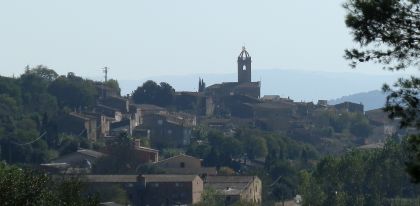 The path emerges into fields and a pig farm. Across the fields are buildings - these were going to be a thermal spa. Apparently at one point they were doing test drilling for oil, but they didn't find it. Instead they discovered hot water. So the intention was to build a baleanari fed by the hot water. At least that was the plan until the money ran out.
The path emerges into fields and a pig farm. Across the fields are buildings - these were going to be a thermal spa. Apparently at one point they were doing test drilling for oil, but they didn't find it. Instead they discovered hot water. So the intention was to build a baleanari fed by the hot water. At least that was the plan until the money ran out.
We walk into Jafre along the upper road. From the geography it seems that this might have been on the upper bank of an ancient lake from millions of years ago. Maybe the Ter or the sea were much much higher then. But enough speculating, we enter what is a relatively linear village and walk to the church, with the old castle building attached. Jafre is more work-a-day than Colomers but retains it's older buildings.
Hot from the sun we rest on a bench next to the church, before walking down the hill and out to the flat of the Ter's floodplain. The path doesn't connect us to the river though and we walk through fields recently stripped of maize across to Colomers, stopping to visit the bird hide that looks out over the river and weir.
Neighbouring walks: Vilopriu and Valldavia - Rupia and Foixa - Verges, Tallada d'Emporda and Maranya - Sant Jordi Desvalls, Colomers and Sant Llorenç de les Arenes
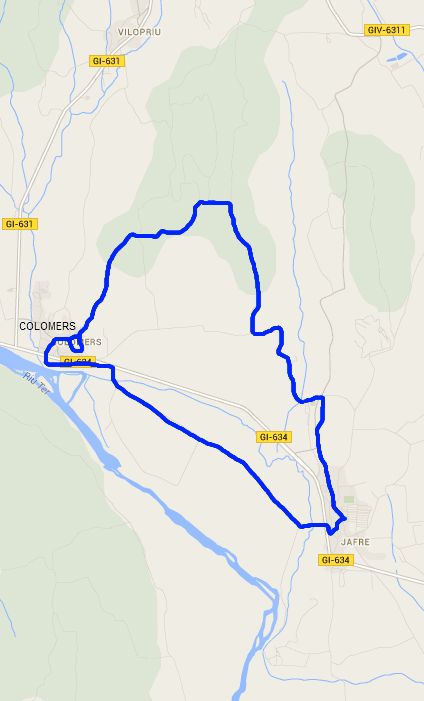
Girona - Festa Major of Sant Narcis
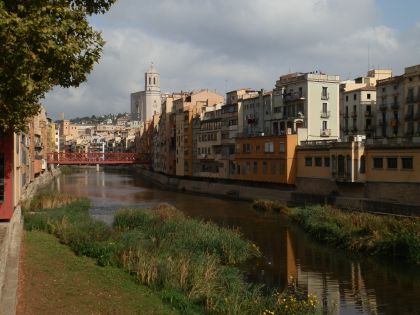 Girona is the closest city for the Costa Brava and capital of the comarca of Girones which takes in the whole of the north eastern corner of Catalonia. It's about 40-50km from the coast and so an easy day-trip for shopping or visiting. The city itself is famous for its old quarter - a collection of unspoilt streets with old arched arcades and trendy shops that sit above the Onyar river and climb up the Capuchins hill. This old quarter contains the Cathedral, to the massive old city walls, a number of other churches and former monestaries and leads to gardens around the newer medieval walls.
Girona is the closest city for the Costa Brava and capital of the comarca of Girones which takes in the whole of the north eastern corner of Catalonia. It's about 40-50km from the coast and so an easy day-trip for shopping or visiting. The city itself is famous for its old quarter - a collection of unspoilt streets with old arched arcades and trendy shops that sit above the Onyar river and climb up the Capuchins hill. This old quarter contains the Cathedral, to the massive old city walls, a number of other churches and former monestaries and leads to gardens around the newer medieval walls.
Girona has a long and hard-fought history. The city sits at the edge of the Gavarres hills, which rise up behind the city, on the confluence of the river Ter (from the Pyreneeds) and Onyar (from Montseny). It is therefore historically and strategically on an important gateway into the Iberian Peninsula. Over the years, Girona is a city which has been besieged about 26 times with the ebb and flow of Spanish and French influence on the area and in the Napoleonic wars was briefly the capital of the French department of Ter.
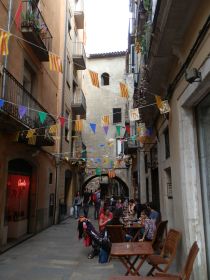 We're visiting at the festival of Sant Narcis, the patron saint of the city in what is Girona's Festa Major. Legend has it when Girona was occuped or beseiged by the French, huge flies emerged from the sacred remains of Sant Narcis and attacked the french soldiers and horses causing many deaths. As a result, across the streets and on the floor are banners with flies - the city's symbol.
We're visiting at the festival of Sant Narcis, the patron saint of the city in what is Girona's Festa Major. Legend has it when Girona was occuped or beseiged by the French, huge flies emerged from the sacred remains of Sant Narcis and attacked the french soldiers and horses causing many deaths. As a result, across the streets and on the floor are banners with flies - the city's symbol.
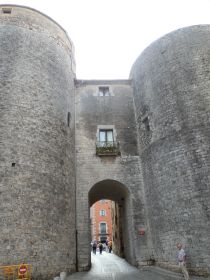 It's useful to understand the geography of Girona as it helps explain where the key parts of the city are. Girona has Iber origins, but the start of the city of today came with the Romans who created the first town (Gerunda) in a triangle formed by the Onyar, the stream of Sant Daniel, and then up into the hill of the Capuchins. This is a relatively small area and the current situation of the Cathedral and Casa del Alemanys. Over time the city grew to the South along the river Onyar in what has become the Barri Vell old quarter. It was also heavily fortified, but in the 19th century the fortifications were removed and the city grew on the opposite side of the river. As a result the train station side of the town is quite modern and a contrast to the old original city areas.
It's useful to understand the geography of Girona as it helps explain where the key parts of the city are. Girona has Iber origins, but the start of the city of today came with the Romans who created the first town (Gerunda) in a triangle formed by the Onyar, the stream of Sant Daniel, and then up into the hill of the Capuchins. This is a relatively small area and the current situation of the Cathedral and Casa del Alemanys. Over time the city grew to the South along the river Onyar in what has become the Barri Vell old quarter. It was also heavily fortified, but in the 19th century the fortifications were removed and the city grew on the opposite side of the river. As a result the train station side of the town is quite modern and a contrast to the old original city areas.
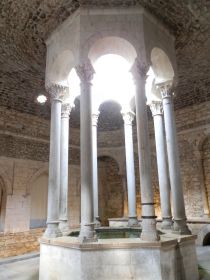 Girona's location as a gateway to Spain and a key route for invaders from France, is combined with the importance of Girona as a religious centre meaning a large number of historic buildings, fortifications and churches in a relatively small area.
Girona's location as a gateway to Spain and a key route for invaders from France, is combined with the importance of Girona as a religious centre meaning a large number of historic buildings, fortifications and churches in a relatively small area.
We're broadly ambling through the city looking for nooks and crannies so pretty much like tourists starting from the batch of Cortes Ingles buildings just south of the train station. Cortes Ingles is the main Spanish department store, comparatively expensive but with relatively high quality products - sort of like a House of Fraser or John Lewis.
 We walk up to the station to see a bricklaying competition which is part of the Festa Major. Teams of bricklayers are making copies of a complex chimney structure. All the teams are making the same structure from the same plans and it includes slopes and diagonals and by no means easy to construct. Each one is freestanding with verticals and angles carefully marked out with wooden splints so as to get the lines correct, and the teams sweating to build the structures as quickly as possible.
We walk up to the station to see a bricklaying competition which is part of the Festa Major. Teams of bricklayers are making copies of a complex chimney structure. All the teams are making the same structure from the same plans and it includes slopes and diagonals and by no means easy to construct. Each one is freestanding with verticals and angles carefully marked out with wooden splints so as to get the lines correct, and the teams sweating to build the structures as quickly as possible.
From the station we zigzag through the new part of the city. The modern area has the main shopping chains and standard clothes shops. As a result, the first impressions that most people get of Girona from the station are of a work-a-day city. It's not until we get to the Onyar and cross the bridge that we get to the classic Girona view of tall terraced houses standing over the river with the cathedral dominating in the background.
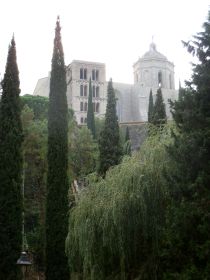 We cross the river at the stone road bridge, browsing at the craft market stalls on the bridge for the festivities. Immediately on the other side of the river we have the older part of the city. Deep arcades provide shade from the hot sun and restaurants have tables out on the pavements. The Barri Vell is practically car free except for the odd intrepid local resident. The streets run in three parallel routes towards the Cathedral area with lanes and arched link paths connecting the roads and steps and climbs on the leftmost street linking to the higher parts of the old town. The shopping is ecletic with many small boutiques and specialist shops mixed in with bars and restaurants. We weave through the alleys and streets festooned with colourful banners marked with a housefly graphic, gradually making our way towards the Cathedral area at the end. The past the Cathedral and out through the enormous old wall and main city gate. Parts of the wall here are roman and the wall itself is both extremely thick and high.
We cross the river at the stone road bridge, browsing at the craft market stalls on the bridge for the festivities. Immediately on the other side of the river we have the older part of the city. Deep arcades provide shade from the hot sun and restaurants have tables out on the pavements. The Barri Vell is practically car free except for the odd intrepid local resident. The streets run in three parallel routes towards the Cathedral area with lanes and arched link paths connecting the roads and steps and climbs on the leftmost street linking to the higher parts of the old town. The shopping is ecletic with many small boutiques and specialist shops mixed in with bars and restaurants. We weave through the alleys and streets festooned with colourful banners marked with a housefly graphic, gradually making our way towards the Cathedral area at the end. The past the Cathedral and out through the enormous old wall and main city gate. Parts of the wall here are roman and the wall itself is both extremely thick and high.
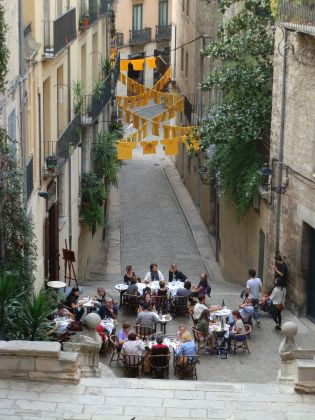 We turn back towards the Cathedral, drawn towards the church of Sant Pere de Galligants with its romanic tower just at the end of the Sant Daniel valley. The area is quiet with gardens at the back of the Cathedral and we realise we're standing close to the Arab Baths. The baths are part of Girona's medieval heritage built to imitate muslim style baths. The baths now are a series of rooms lit by open geometrical skylights that bring light flooding into the space and a pool of water under columns that reach to a skylight. Unlike the rest of Spain, Catalonia was only under Moorish control for about 80 years (718 to 801), however, Girona cathedral sits on the site of a mosque from that period. Girona also has vesitages of its Jewish inhabitants in the Call Jeue.
We turn back towards the Cathedral, drawn towards the church of Sant Pere de Galligants with its romanic tower just at the end of the Sant Daniel valley. The area is quiet with gardens at the back of the Cathedral and we realise we're standing close to the Arab Baths. The baths are part of Girona's medieval heritage built to imitate muslim style baths. The baths now are a series of rooms lit by open geometrical skylights that bring light flooding into the space and a pool of water under columns that reach to a skylight. Unlike the rest of Spain, Catalonia was only under Moorish control for about 80 years (718 to 801), however, Girona cathedral sits on the site of a mosque from that period. Girona also has vesitages of its Jewish inhabitants in the Call Jeue.
(In 1492, the same year that Christopher Columbus discovered America, Spain also expelled non-Christians from its lands with Muslims and Jews being forced to leave or convert. The process of investigating 'converts' was the role of the Spanish Inquisition. Many muslims left to North Africa only to come back to raid the Spanish coast as Barbary Corsairs.)
From the Arab baths we wander out to Sant Pere. A guitarist is playing classical guitar in the courtyard just outside the church. The lane behind the church links up to Sant Daniel path and up into the Gavarres. Though we are in the heart of the city at this point it's almost like a finger of the countryside is touching the ancient heart. The gardens at the back link up to the Cathedral now dominating above us on the hillside.
We climb through the steps in the gardens to reach the Casa del Alemanys, then follow the paths back down into towards the city seeming to pass church then monestary then church. The area now houses the University of Girona but previously there were seminaries for priests. The monastic buildings were also used as makeshift jails during Franco's time.
The paths and steps down run back into the Barri Vell and, as it's lunch time, everyone seems to be eating outside. For October it's unseasonally warm. As with most of Catalonia, when lunch comes everything bar the restaurants shut down. We leave Barri Vell by the metal bridge into the main square where stalls are selling meats and cheeses. A man with a clowns nose is playing trumpets and drums as a very tuneful and fun one man band with a handful of children dancing to his song.
We cross over the road to the Devesa Park hoping to see something on the stage, but being lunchtime it's closed - only a few stalls selling roast chestnuts are open. Further down into the park are the fairgrounds but we give those a miss and gently wend our way back.
Girona walks: Girona valley of Sant Daniel - Gavarres Montnegre and Montigalar - Ruta del Carrilet - Girona cyclepath to the coast - Bescano, River Ter and free-style kayaking - Girona and Castell de St Miquel - Roman fort at St Julia de Ramis (Girona) - Girona - Festa Major of Sant Narcis - Girona Temps de Flors
Nearby: Figueres and Castell de Sant Ferran - Olot - capital of Garrotxa - Banyoles lakeside walk - Visit to Besalu and Banyoles
Visit to Roda de Ter and Espinelves
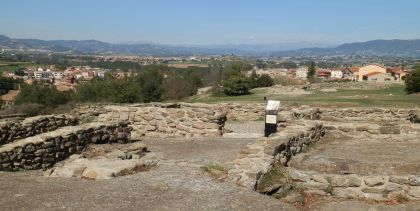 One of the great delights of Catalonia is how quickly the terrain and countryside changes from one location or one area to the next. It means that you don't have to travel very far to get a completely different landscape. And in particular we can choose where to go for each particular season. So in summer we have the beaches, in winter the snow on the Pyrenees and in the autumn we have Montseny.
One of the great delights of Catalonia is how quickly the terrain and countryside changes from one location or one area to the next. It means that you don't have to travel very far to get a completely different landscape. And in particular we can choose where to go for each particular season. So in summer we have the beaches, in winter the snow on the Pyrenees and in the autumn we have Montseny.
Montseny is the mountain situated between Barcelona and Girona rising to about 1700m. In contrast to the more famous arid rocky fingers of the mountain of Montserrat, or the higher mountains of the Pyrenees, Montseny is a more gentle giant - softer and more deciduous, so when autumn comes it's the mountain to visit for mushrooms, chestnuts and to see the changing colour of the leaves.
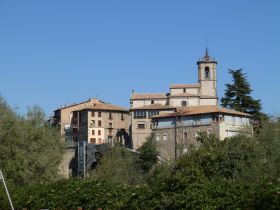 In the past year they've completed the C25 dual carriageway link that connects Girona to Vic and on to Lleida so the initial aim of our visit was really Roda de Ter, a town that sits above an oxbow of the river Ter close to the town of Vic. The road climbs up through the side of Montseny over the col and down to the Plain of Vic and as drives go it's very pretty through wooded hillsides and then with a grand vista across Vic and to the Pyrenees. The Plain of Vic is a great contrast to the relatively cultured Emporda landscape - much rougher in appearance with small round dry hills and views to cliff-y rockfaces (cingles) with houses almost tumbled on top of each other in an area that looks much drier than the fields of the Costa Brava.
In the past year they've completed the C25 dual carriageway link that connects Girona to Vic and on to Lleida so the initial aim of our visit was really Roda de Ter, a town that sits above an oxbow of the river Ter close to the town of Vic. The road climbs up through the side of Montseny over the col and down to the Plain of Vic and as drives go it's very pretty through wooded hillsides and then with a grand vista across Vic and to the Pyrenees. The Plain of Vic is a great contrast to the relatively cultured Emporda landscape - much rougher in appearance with small round dry hills and views to cliff-y rockfaces (cingles) with houses almost tumbled on top of each other in an area that looks much drier than the fields of the Costa Brava.
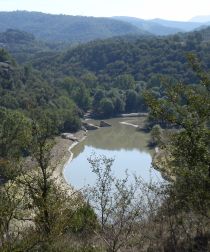 The reason for visiting Roda de Ter is that above the oxbox is the ruins of an village established by the Ibers that existed until medieval times at L'Esquerda which, from photographs and maps looked like it would be somewhere to explore as the river Ter at Roda is already a broad river even though the town is quite inland. The next stretch of the river would pass through a number of dams and at Roda it is starting to snake its course through the hills before emerging on the other side near Girona.
The reason for visiting Roda de Ter is that above the oxbox is the ruins of an village established by the Ibers that existed until medieval times at L'Esquerda which, from photographs and maps looked like it would be somewhere to explore as the river Ter at Roda is already a broad river even though the town is quite inland. The next stretch of the river would pass through a number of dams and at Roda it is starting to snake its course through the hills before emerging on the other side near Girona.
Roda itself feels like a small town. The church is the most prominent building and there are two bridges over the river. There is an older heart and then newer houses around the outside. We navigated our way to the L'Esquerda prow where there is a small museum and some information signs around the ruins. The promentary is high-ish up with cliffs down to the river on two sides which means we couldn't explore down to river level. Most of the ruins are low stone walls with the exception of one larger standing wall from the old church. It would be fair to say that we were a little disappointed. We were expecting something with more of a visitor focus that made more of what could be seen and the dramatic bow the river makes and with easier access to the river level.
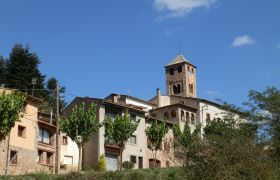 The town itself is quite small and sits high above the river. The old bridge has a double row of arches - as if they built a new bridge on top of the older bridges foundations. The one remarkable thing we did find was a high water marker from 1940. We had to look up to see it - it was about 3m above us. Where we were standing to see the sign was already about 4m above the normal river level. So at some point the water must have been about 10-12m higher. There are walks along the Ter - there is a route that links the source in the Pyrenees to Torroella - and we could have explored a little more, but with no map we weren't sure of round trips.
The town itself is quite small and sits high above the river. The old bridge has a double row of arches - as if they built a new bridge on top of the older bridges foundations. The one remarkable thing we did find was a high water marker from 1940. We had to look up to see it - it was about 3m above us. Where we were standing to see the sign was already about 4m above the normal river level. So at some point the water must have been about 10-12m higher. There are walks along the Ter - there is a route that links the source in the Pyrenees to Torroella - and we could have explored a little more, but with no map we weren't sure of round trips.
So having run out of things to see we headed back on the C25, but took a brief diversion to Espinelves which we had seen from the road on the way out. Espinelves is a small village in among the hills of Montseny but extremely well preserved and cared for. Each house had flowers in their gardens or on their windows and the old stone houses had almost all been renovated without changing their original style. Even the modern houses were in keeping with the older ethos and it almost felt like a little Swiss village with views of Montseny peaks in the background. There were several restaurants and walkers about and a delicious golden hue to the light through the trees.
Nearby: Castell de Montsoriu - Santa Coloma de Farners - Brunyola - Arbucies autumn walk - Visit to Roda de Ter and Espinelves - Rupit - Ribes de Freser and skiing at Vall de Nuria
Romanya de la Selva to Puig d'Arques
 The highest point on the Gavarres hills is at Puig d'Arques (535m) marked by a tower with a large white dome on top. The dome is visible from miles away and we always thought it was an observatory from a distance. The peak itself sits in the very heart of the Gavarres and is quite remote from other towns or villages. This means there are a variety of places we could start the walk - Calonge, La Bisbal or, as we chose Romanya de la Selva - it's about 7-8km from Romanya.
The highest point on the Gavarres hills is at Puig d'Arques (535m) marked by a tower with a large white dome on top. The dome is visible from miles away and we always thought it was an observatory from a distance. The peak itself sits in the very heart of the Gavarres and is quite remote from other towns or villages. This means there are a variety of places we could start the walk - Calonge, La Bisbal or, as we chose Romanya de la Selva - it's about 7-8km from Romanya.
Because of the relatively remoteness and because other places on top of the Gavarres are only accessible on gravel tracks we didn't want to try to get closer without knowing what the roads would be like. As it happens, there is a tarmacked road to Puig d'Arques which we took as our route back, but we didn't know this beforehand and experience of roads in remote areas disappearing into a pitted track meant we didn't want to take the risk.
So starting at Romanya, rather than trying to get closer seems a good bet. The disadvantage was not so much the distance but we couldn't tell how easy it would be to make a round trip. In the end we took the marked GR92.1 (one of the extensions off the coastal GR92) out and the road back, but there is a path on the maps which descends into Vall Repos as a possible alternative route back. Again, not knowing the area so well we were a little cautious and stuck to an easy route.
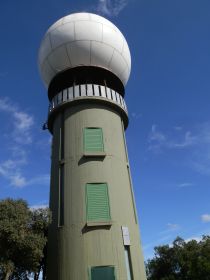 We've covered Romanya de la Selva. This time we didn't visit the village itself but headed straight out. The GR92 starts past the cross and then follows the road to Calonge for a little way, on past the roadway to Puig d'Arques, past the cemetary and close to the Cova de Daina - a small neolithic burial chamber - turning to the left and following a track into the woods.
We've covered Romanya de la Selva. This time we didn't visit the village itself but headed straight out. The GR92 starts past the cross and then follows the road to Calonge for a little way, on past the roadway to Puig d'Arques, past the cemetary and close to the Cova de Daina - a small neolithic burial chamber - turning to the left and following a track into the woods.
As we entered, there were signs up warning of hunters looking to shoot wild boar in among the woods. Often the hunters bring dogs too, mainly two or three for tracking, and occasionally you will hear the whistles and barking in amongst the trees. The hunters weren't the only people out. October is the start of mushroom season and mushroom hunting is a very popular weekend activity in the hills of Catalonia. We also passed a number of chestnut trees (Castanyas) and they're also nearly ready for collecting - a treat for halloween and the end of October.
The path runs through the woods with a deep valley (Vall Repos) to the right and the occasional view of the sea. It's a gentle upwards climb, but not particularly steeps and down in the valley we can see scattered isolated masias in among the trees. The path continues for a while. It's clear blue sky, but fresh enough to walk, though just in a t-shirt with a definite coolness as we curl around the shadier side of the hill. The track's wide enough for 3 or 4 people side by side, but no more, so we're a little surprised to see car tracks and cars parked in the woods as the mushroom hunters scurry around under the trees.
 Eventually the path curls around to meet the roadway up to Puig d'Arques. As mentioned, we weren't sure what quality of road this was, but it turns out that though narrow and quiet, it looks relatively recently updated and in good condition. The road itself runs along the first of the hill ridges giving views down the valley to the sea, or on the otherside out across the hills towards Cassa de la Selva and Montseny in the distance. On the ridge itself is a farmhouse in the process of renovation and fields of sunflowers past their best.
Eventually the path curls around to meet the roadway up to Puig d'Arques. As mentioned, we weren't sure what quality of road this was, but it turns out that though narrow and quiet, it looks relatively recently updated and in good condition. The road itself runs along the first of the hill ridges giving views down the valley to the sea, or on the otherside out across the hills towards Cassa de la Selva and Montseny in the distance. On the ridge itself is a farmhouse in the process of renovation and fields of sunflowers past their best.
We're also not the only ones visiting and we see other walkers, cyclists and the odd car heading to or from Puig d'Arques. Eventually we reach a crossroads. The road itself curls up to the right while we take the left hand path to Col de la Moixa, back into the woods again. This path climbs more vigorously with views out towards the Pyrenees through the trees. We're surprised to pass an inhabited house just off the path - it looks like the track we're on would be their access road but it barely seems wide-enough through the trees.
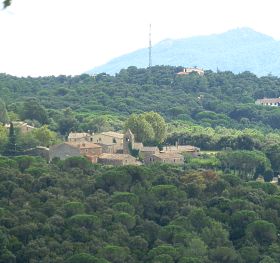 Another junction and we continue to follow the signpost to Puig d'Arques passing under the occasional chestnut tree with the first prickly castanya shells on the floor, but looking like boars might have taken the contents. Onwards and upwards and we get to a choice - Puig de Gavarres, or Puig d'Arques. The sign post says Puig de Gavarres is just a little higher than Puig d'Arques, but we continue to the tower at Puig d'Arques where it says the reverse.
Another junction and we continue to follow the signpost to Puig d'Arques passing under the occasional chestnut tree with the first prickly castanya shells on the floor, but looking like boars might have taken the contents. Onwards and upwards and we get to a choice - Puig de Gavarres, or Puig d'Arques. The sign post says Puig de Gavarres is just a little higher than Puig d'Arques, but we continue to the tower at Puig d'Arques where it says the reverse.
The tower with the dome on top looks more like an observation post - it doesn't look like an observatory from close up, and the tower itself is closed, but next door is a viewing platform and the views are immense - almost a 270 degree panaroma across the Emporda region - and we wish we'd taken binoculars up.
For the return journey we head down and find the road. There's the option of going down to Vall Repos, but we've already done 7km and the children don't want to have a diversionary explore into Vall Repos, so instead we take the easy way down and follow the tarmacked road still remarking at how deep the valley seems to our left.
At the lower point we could go back on the GR92 track, but we stay on the road and get the treat of views across Sant Miquel d'Aro and across the valley to Romanya de la Selva. Otherwise it's straightforward and we get back, past the cross that we started at.
Neightbouring walks: Romanya de la Selva - Via Ferrata at the Gorges de Salenys - Calonge (Cami de Molins and over Cabanyes) - Castell d'Aro and estate of Mas Nou - St Pol de Bisbal and Santa Lucia
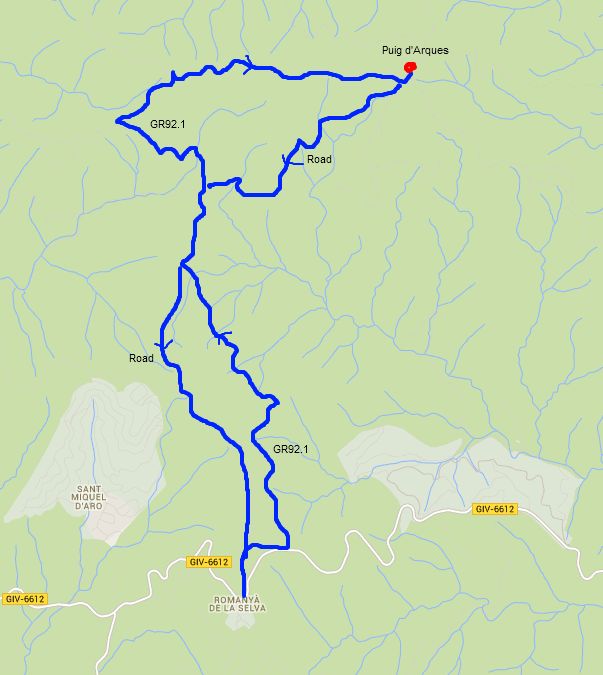
Swimming and wild beaches of Castell-Cap Roig
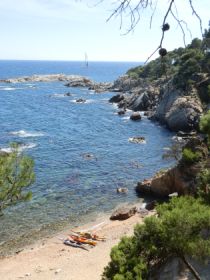 Between Cap Roig, just south of Calella de Palafrugell and the beach at Platja de Castell, are a series of wild natural beaches and coves that start from El Crit (Mont-ras) and then run into Cala Estreta and around to Cala Senia.
Between Cap Roig, just south of Calella de Palafrugell and the beach at Platja de Castell, are a series of wild natural beaches and coves that start from El Crit (Mont-ras) and then run into Cala Estreta and around to Cala Senia.
The beaches themselves are mostly sandy in little coves, but with rocky bays and a mass of small islets. It is easiest to envisage as a series of six or eight small beaches or bays connected by footpaths over the headlands. This is very much a natural area, though there is the odd fisherman's building on each beach. As a result the beaches are very popular with naturists/nudists almost all year round (there is a naturist campsite Relax Natur between Cap Roig and Mont-ras)
Although it is possible to drive and park above the beaches out-of-season, during the peak summer months access is only available to walkers and bikers from the path that runs across the top from just outside Cap Roig connected to Platja de Castell. Paths drop off the upper route down the hillside to the beaches below.
The isolated nature of the beaches, and the ease of reaching them by canoe from Calella de Palafrugell or Castell mean that they are popular destinations for canoeists, while the rocky bay makes them popular with snorkellers, though the bays can be a little difficult to get into because of the rocks underfoot.
Facilities at the beaches
There are no facilities at the beach and no lifeguards. These are left wild and open deliberately. Each of the beaches has a fisherman's hut and sometimes one or other of these building is open. The only concession is that the swimming area is marked by buoys out into the bay. The beaches typically sit under cliffs (take care for falling rocks) and visitors to the beach might make fires for barbecues and occasionally you see a tent with people wild camping, but it's not encouraged.

Sand quality
The sand quality varies according to the beach. From Cala Estreta around, the beaches are mainly of a fine to slightly yellow coarse sand which is fine for sunbathing. El Crit, the beach closest to Cap Roig, has one half of the beach that is coarse sand, and a second half, through the hole in the rocks, that is pebbly. The main problem for swimmers or paddlers, is that the bays themselves are rocky underfoot almost immediately, making entry and exit from the water hard under foot.
Swimming
The small bays are relatively shallow with lots of rocks at the bottom and clear water. This means the water can be warm even into September, but the rocks at the bottom mean you do need to watch for the depth of water - in some places rocks get close to the surface and in other places a shallow rocky bottom can sudden drop into a deeper hole. It's advisable to wear goggles and to look how far the sea bed is beneath you when swimming - it's very easy to start to treadwater only to find yourself kicking a boulder.
The main problem for swimming is normally picking a path among the rocks when getting in and out. In El Crit, and some other places, it's easier to get in from the rocks at the side of the bay than to get in from the beach itself, but again be careful with water depth - the unevenness of the bottom, means it's not suitable for diving from the rocks into the water.
 The open and wild nature of the bays mean there are lots of fish, sea plants and wildlife in the water (potentially including the odd jellyfish). Out towards the islands and rocks away from the shore, the sea can become choppy so some care is needed when there is a swell on the sea. The shorter nature of the bays and the risk of hitting rocks mean it can be difficult for long distance swimming, but make it perfect for snorkels and exploring.
The open and wild nature of the bays mean there are lots of fish, sea plants and wildlife in the water (potentially including the odd jellyfish). Out towards the islands and rocks away from the shore, the sea can become choppy so some care is needed when there is a swell on the sea. The shorter nature of the bays and the risk of hitting rocks mean it can be difficult for long distance swimming, but make it perfect for snorkels and exploring.
Canoeing
Lots of people access the beaches by canoe, or use canoes to explore the rocky headlands or to navigate among the islands. Canoe hire can be made at Platja de Castell. It's easy to pick routes between the islands and the sandy beach makes it safe to take the canoes out of the water. Again, when coming close to the beaches, do watch for rocks. Being relatively open getting out of the bays and around the headlands, the water is more exposed and can be choppy on windy days.
Parking
Outside the main high season, when the access road at the top is open there is parking above Cala Senia and a little above Cala Estreta, but the road is a gravel track and driving can be difficult. We would park and walk from Cap Roig to reach the beaches (about 10-15 minutes). The alternative is to park at Cap Roig, but the walk is a little longer.
Walks
The path along the beaches was included in the Calella de Palafrugell/Cap Roig to Castell - classic wild Costa Brava walk. The Ruta del Tren Petit path has access points to the beaches if you are coming from Palamos, Vall-llobrega or Mont-ras.
Next beaches
South to Platja de Castell - North to Calella de Palafrugell
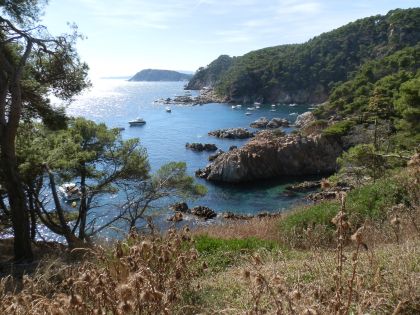
Mont-ras to Fitor and on to Fonteta and Vulpellac
 The Gavarres hills are the major inland geographical feature of the Costa Brava. These are hills that rise to about 500m at the extremes and stretch from just behind Girona to the hills at Mont-ras, just behind Palafrugell.
The Gavarres hills are the major inland geographical feature of the Costa Brava. These are hills that rise to about 500m at the extremes and stretch from just behind Girona to the hills at Mont-ras, just behind Palafrugell.
The hills are a protected natural area with a great number of tracks and paths, almost totally accessible to the public.
The terrain is mostly wooded with cork and alzina oak trees, but with lots of hidden valleys and streams with occasional ancient masia farmhouses.
As a natural space, the Gavarres are wonderful for walking and exploring with views to the coast from all directions yet feeling almost completely separate from civilisation as the hills are only crossed by road in three places - at Els Angels, between Sant Sandurni and Cassa de la Selva and between La Bisbal and Calonge.
There are other gravel tracks and forestry routes into the hills but these are only really suitable for 4x4s with good ground clearance. As a result it's a fabulous area for walkers and particularly mountain bikers.
In the hills directly above Mont-ras/Palafrugell is a small isolated church at Fitor from the 10th Century. As you skirt the hills from below, you'll often find a Cami de Fitor referring to a path that climbs into the woods and take you to the church.
For many people here, walking to Fitor is something of an annual pilgrimage to reconnect with the Gavarres and local history.
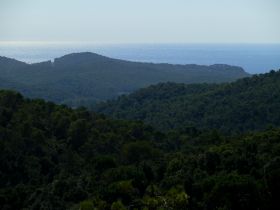 We've walked up three or four times. The first time we did it was pretty much straight up and down, but as it's a relatively long way up to Fitor (about 6-7km) and because from Fitor you can walk down in any direction, now we tend to walk to the church, then down to one of the other towns in a different direction. This means it's a linear walk so we have to arrange transport back.
We've walked up three or four times. The first time we did it was pretty much straight up and down, but as it's a relatively long way up to Fitor (about 6-7km) and because from Fitor you can walk down in any direction, now we tend to walk to the church, then down to one of the other towns in a different direction. This means it's a linear walk so we have to arrange transport back.
This time we're just in the middle of September and it's time for our annual visit. Temperatures are still warm but there is a freshness returning and the air is becoming clearer so the views to the distance are returning.
We're starting in Mont-ras with an aim of walking over the top to Fonteta just outside La Bisbal. There are a myriad of routes up into the hills and even though there is good signposting, it's very easy to get waylaid without a map - Google just doesn't show enough routes.
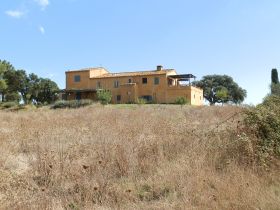 We start at Mont-ras church and walk up into the hills along the track with the misnomer of Carrer Major. We walk this area a great deal and there are numerous routes up to the top at Col de Boquera - including the route take on the Mont-ras Fountain walk.
We start at Mont-ras church and walk up into the hills along the track with the misnomer of Carrer Major. We walk this area a great deal and there are numerous routes up to the top at Col de Boquera - including the route take on the Mont-ras Fountain walk.
We take one of the easier paths that winds its way up the side of the hill. At Col de Boquera, we're on the 'road' - a wide gravel track that is suitable for vehicles and is used as an access to the farms on the top of the hill.
The road is always a little too broad and a little too dusty so we don't take it too often, but its the main connecting route to Fitor. It runs along a saddlepoint. and through the trees on one side you can look out to the coast at Pals, and then a few minutes later on the other side you can see the sea in the direction of La Fosca with the valley of the 'Mont-ras boar walk' down below.
 The road runs all the way up to the farm-houses on the top, which is where we're aiming to reach, but we prefer smaller tracks, and half way along the part of the road with views to La Fosca, there's a track that runs up the side of the hill to the right.
The road runs all the way up to the farm-houses on the top, which is where we're aiming to reach, but we prefer smaller tracks, and half way along the part of the road with views to La Fosca, there's a track that runs up the side of the hill to the right.
This is a narrower path only suitable for walking or biking (it has lots of bike tracks in the dirt). This path climbs around the hill in amongst the woods and trees and we just have to remember to take the left hand fork at the only point the path splits.
Eventually (15-20 minutes) it reaches the top road signposted to Llofriu down, or to the left around the top to Fitor.
We head towards Fitor and can see Mas Torroella on the other side of the hill - the road passes what is a very sturdy looking masia, but we won't reach that far.
Following the road, we pass Can Carrony - a large orange painted masia that stands on the crest with views out across Begur and Calella to the sea. The farmhouse is quiet, but we've passed when there have been great gatherings of visitors taking lunch outside.
The farmhouse also sits in a flat area of fields. It always seems a little surprising that coming out of the dense woods below, at the top it's open with fields. Historically though, this is an area that has been farmed for centuries and for the group of farms on the top, Fitor was their church.
 We take the road between the fields, still in the direction of Fitor and come to a crossroads. A motorcyclists on a track bike is buzzing across the road - the area is also popular for off-road moto too.
We take the road between the fields, still in the direction of Fitor and come to a crossroads. A motorcyclists on a track bike is buzzing across the road - the area is also popular for off-road moto too.
At the crossroads the main signs point to the left along the road to Fitor, but look out for a darker green pedestrian sign which indicates straight-on. The left hand road is broad and runs along the top, but is a longer route to Fitor. The footpath is shorter and prettier so we head straight on looking out for yellow-white flashes, which aren't always that easy to see.
The path runs into the woods and then through to more fields. We're heading to Mas Plaja, but an arrow to the left points to Fitor Viens (Fitor neighbourhood). It takes a while, but we find the yellow-flashes on the right hand path and continue down to Mas Plaja, an old masia festooned with flowers.
Again we lose the yellow-white flashes and have to check on the map. At Mas Plaja we have to take a left along a track that seems to run past their horta (vegetable garden). It's then across a stream - there's water up on the Gavarres even at this time of year - and up to Fitor.
You can see the church at Fitor standing isolated in among the fields from the track as you get closer. It's been renovated in the last two or three years, but it retains a charm and character, not least because the small tower isn't quite vertical.
The church sits next to a small old house which is used as an occasional shop for refreshments, but then that is it - no other village or buildings nearby at all.
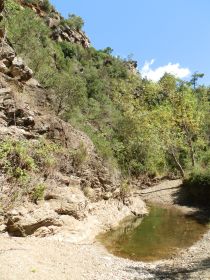 As we come to the church we pass a car parking area, so it is possible to drive up the tracks if the walk seems too much.
As we come to the church we pass a car parking area, so it is possible to drive up the tracks if the walk seems too much.
Normally, we would also see mountain bikers at Fitor, taking a break on the picnic tables, but this time there is no-one about. From the church itself a number of different tracks and paths run off in different directions - to Calonge, or to Palamos or down to Vall.llobrega and Bell.lloc castle.
We keep on the yellow-white route in the direction of Fonteta and just as we leave Fitor we meet another person coming up the other way. The track runs downhill and then splits at Can Cals.
We take the left fork and then take the next track to the left down and across the valley, but it seems that the paths would have converged. Around Can Cals, a small stream is still within the rocks, but still has water it and over the next little while the path follows the stream down until we reach another set of rock-pools underneath a small rocky outcrop.
As an explore we walk along the rocks of the stream, disturbing lots of small frogs who jump back into the water as we pass. In winter with full rain, it looks like the stream could easily be a torrent through here.
Back on the path and we get the first sight of Mas Anguila a very large impressive masia sitting on top of an isolated hill above the valley in the process of being renovated.
The path takes us in a semi-circle around the Mas so we keep catching glimpses of it as we walk. The path continues over the Pujada Rossa and to La Creu dels Frares. At La Creu, we can look out across the Empordan plain out to Torroella and the Isles Medes in the distance.
It's not long now, and we come down the hill emerging past a riding school before finally getting onto tarmac and into Fonteta. We walk through the centre, then out to Vulpellac for our lift home.
Neighbouring walks: La Bisbal, Vulpellac, Castell d'Emporda, Fonteta - Mont-ras Fountain walk - Mont-ras 'boar' walk -
Calonge into the Gavarres - Bell-lloc and Castell de Vila-Roma (Palamos) - St Pol de Bisbal and Santa Lucia - Santa Susanna de Peralta and Sant Climent de Peralta - Romanya de la Selva to Puig d'Arques

L'Estartit to Cala Pedrosa and Cala Ferriol
 Although originally L'Estartit was a fishing village it has become more of a resort catering to holidaymakers and second-home owners including a reasonable community of British ex-pats. It's also the connection route to the diving mecca of the Isles Medes, which according to diving friends, is one of the best locations on the Mediterranean.
Although originally L'Estartit was a fishing village it has become more of a resort catering to holidaymakers and second-home owners including a reasonable community of British ex-pats. It's also the connection route to the diving mecca of the Isles Medes, which according to diving friends, is one of the best locations on the Mediterranean.
The town of L'Estartit always feels like going to a different country. The town is slightly isolated as access is only possible from Torroella de Montgri with the river Ter to the south, and the Montgri hills to the back preventing any other access. Consequently, the town is almost entirely geared to holidaymakers as it is not really well enough connected for local inhabitants. Having said it's mainly for holidaymakers, this is not in a large or overgrown way, but it does have some well-design holiday hotels and apartment blocks and the main strip in the town is almost entirely shops focused on the tourist trade (and dead quiet in winter).
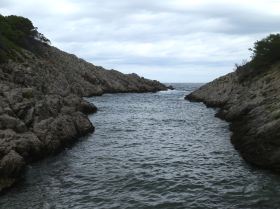 The town's strong point for locals is that it is the main access point for the Isles Medes, two islands off the coast sufficiently large to have a lighthouse, that are the centre of a sea-based nature park famed for the quality of the diving. If you're visitng L'Estartit, then taking one of the many glass-bottomed boats to the Islands is recommended. If you're a diver (we're not), friends really recommend the Isles Medes.
The town's strong point for locals is that it is the main access point for the Isles Medes, two islands off the coast sufficiently large to have a lighthouse, that are the centre of a sea-based nature park famed for the quality of the diving. If you're visitng L'Estartit, then taking one of the many glass-bottomed boats to the Islands is recommended. If you're a diver (we're not), friends really recommend the Isles Medes.
Behind the town is the Muntanya Gran of the Montgri mountains a large and very natural set of hills, cliffs and shrub that separates L'Estartit from L'Escala. We've walked this area before but have never quite got it right. The first time we were trying to follow the coast to L'Escala but came in the wrong shoes (the hills have a seriously rough under foot terrain - anything other than good walking shoes is not recommended). There's also a good walk along the ridge top over L'Estartit. Previously we've also tried to get up in to the hills above the furthest point of the port, and now we've discovered the best access point is the road up behind Camping Estartit which makes the start of the journey much easier. Google Maps doesn't show the paths very well, but they are clearly marked with signposts and green-white flashes and easy to follow on L'Emporda en Detall walking maps.
 We normally park near the photographers' shop who always has a great set of local pictures, then walk down to the beach. The beach has a fine sand and is gently sloping, but at the back are large areas used for parking. It rained overnight, so there are a few puddles, but out to sea the Isles Medes are the dominant feature. We explore the town a little - it's not somewhere we come to very often, and even at this late stage in the season there are still visitors from the UK and Netherlands about. After a skirt through the town we head out and follow the road in the direction of Camping Estartit and get the first of the walking signs. The route we're following connects to L'Escala/Montgo as well as the hidden Calas.
We normally park near the photographers' shop who always has a great set of local pictures, then walk down to the beach. The beach has a fine sand and is gently sloping, but at the back are large areas used for parking. It rained overnight, so there are a few puddles, but out to sea the Isles Medes are the dominant feature. We explore the town a little - it's not somewhere we come to very often, and even at this late stage in the season there are still visitors from the UK and Netherlands about. After a skirt through the town we head out and follow the road in the direction of Camping Estartit and get the first of the walking signs. The route we're following connects to L'Escala/Montgo as well as the hidden Calas.
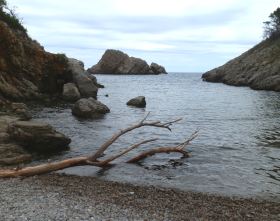 The road runs past the campsite and continues up. To the right, above the campsite are some non-sea cliffs with a path running across the top through the woods (a good local route if you don't want to go fully onto the Montgri hills). Instead we continue with the road and it turns into a track with white painted rocks on either side - part of the access to Torre Ponsa. Our route then splits to the right rising steeply and we can see the grand Torre Ponsa buildings with Montgri Castle behind it. At the head of the road the terrain changes to the more typical Montgri terrain of rough stone underfoot and small shrubs dotted with alzines. At the crossroad, the paths are clearly marked with good signs and we take the route to Cala Pedrosa and Cala Ferriol along a stony track.
The road runs past the campsite and continues up. To the right, above the campsite are some non-sea cliffs with a path running across the top through the woods (a good local route if you don't want to go fully onto the Montgri hills). Instead we continue with the road and it turns into a track with white painted rocks on either side - part of the access to Torre Ponsa. Our route then splits to the right rising steeply and we can see the grand Torre Ponsa buildings with Montgri Castle behind it. At the head of the road the terrain changes to the more typical Montgri terrain of rough stone underfoot and small shrubs dotted with alzines. At the crossroad, the paths are clearly marked with good signs and we take the route to Cala Pedrosa and Cala Ferriol along a stony track.
The path is clear and easy to follow (we pass a couple of mountain bikers coming the other way), then the path to Cala Pedrosa turns off to the left and becomes a little narrower with more stone. The terrain of the Montgri hills has a tendency to get harsh underfoot. It's a bit like walking over the remnants of a collapsed dry stone wall all the time with stones and rocks pointing up at odd angles making the path very uneven. Our path runs down through the woods and then along a dry river bed and we reach Cala Pedrosa (the stony bay). It's a pebble beach, with access to a channel of sea water. The whole beach/channel is about 10m wide at the widest Very natural, very stony and fine for skimming stones across the water, but not much else.
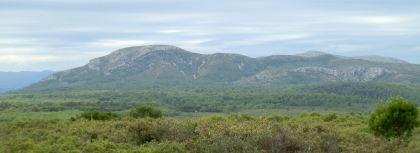 The path now climbs out of the bay and up to the top. After an easy climb we reach a viewing point and can look back towards Cala Pedrosa and the Island of Pedrosa (also very stony), and in front of us we can see the remarkable cliffs and headland of Roca Foradada/Cap del Castell which juts out into the sea with sea cave and sea tunnels at the bottom and behind in the distance we can see Roses and Cap de Creus. The cliffs along the coast are high and vertical, and thankfully the path steers around the back.
The path now climbs out of the bay and up to the top. After an easy climb we reach a viewing point and can look back towards Cala Pedrosa and the Island of Pedrosa (also very stony), and in front of us we can see the remarkable cliffs and headland of Roca Foradada/Cap del Castell which juts out into the sea with sea cave and sea tunnels at the bottom and behind in the distance we can see Roses and Cap de Creus. The cliffs along the coast are high and vertical, and thankfully the path steers around the back.
Now as we're walking we run into a couple of other families with children younger than ours, properly shoe'd up for the rough ground. It feels like we're in the middle of nowhere surrounded by low shrub with no buildings or other access around so it comes as a slight surprise.
 We reach the top of the hill and our children cop out of the next stretch down to Cala Ferriol to avoid another climb out of a bay. We continue though and walk down along a broad but stonily-uneven track to get to Cala Ferriol another pebble beach but broader that Cala Pedrosa. There are a couple of small islets in the bay and a huge cliff above. Among the natural scenery, it looks like humans have created a space for fires in among the rocks.
We reach the top of the hill and our children cop out of the next stretch down to Cala Ferriol to avoid another climb out of a bay. We continue though and walk down along a broad but stonily-uneven track to get to Cala Ferriol another pebble beach but broader that Cala Pedrosa. There are a couple of small islets in the bay and a huge cliff above. Among the natural scenery, it looks like humans have created a space for fires in among the rocks.
On the map there's a second path out of the bay and back to the top, but we have to go back the same way we came. We walk past the families we saw earlier coming down. At the top we follow the flattish path in the direction of L'Escala (still well signposted), and then follow a flat track GR92 back towards Torroella and L'Estartit. We can't see the sea, but to the right as we go south are views towards Montgri and out to Bellecaire d'Emporda and the Pyrenees beyond. The GR92 bears off to the right, but we continue straight on the path to the crossroads where we took the route to Cala Pedrosa. We carry straight on and get to the heights above L'Escala, continuing along the top until we find a route down and back into town.
Neighbouring walks: Torroella de Montgri to Gola de Ter - Sobrestany, Montgri and Bellcaire d'Emporda - Torroella de Montgri castle - L'Escala Riells to sea cliffs and viewpoint of Montgo - Montgri Massif from Les Dunes L'Estartit
Swimming at: L'Estartit
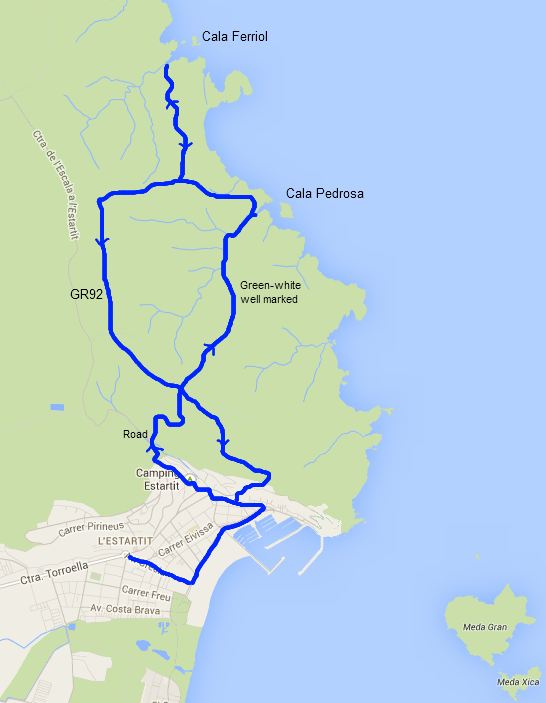
Swimming and beach at Sa Riera (Begur)
 Sa Riera is the largest of the three Begur beaches (Sa Tuna and Fornells/Platja Fondo/Aiguablava being the others) and the closest directly to the Begur town itself, though it is still 2-3km downhill.
Sa Riera is the largest of the three Begur beaches (Sa Tuna and Fornells/Platja Fondo/Aiguablava being the others) and the closest directly to the Begur town itself, though it is still 2-3km downhill.
The beach is situated in a small older village directly around the beach surrounded by hills with select luxury villas.
The village area has a handful of restaurants, a couple of shops and a small supermarket all of which are open during summer, but normally closed out of season. It's picturesque with views, but feels a little more touristy than Sa Tuna or Aiguablava.
The beach is large and sandy at the base of the stream that runs down from Begur, with space for fishing boats to the right-hand side with boats on the beach and in the water.
It is framed by rocky cliffs to the left looking out to sea with a path that runs over the top to Platja de la Isla Roja and Platja de Pals. On the right is a smaller second beach and a small rocky headland with a villa on it.
The beach is north facing and looks directly towards the Isles Medes. If there is a south wind blowing, Sa Riera is protected and remains perfectly calm for swimming.
At the back the road comes down from Begur on a windy road that becomes a relatively narrow valley with low-rise holiday apartment blocks as you come into the main Sa Riera village and the number of villas mean the area is very popular for villa and apartment rentals, but it is typically closed up during the winter.
Facilities at the beaches
Being relatively large and popular there is canoe hire, lifeguards and a diving school at the beach. As mentioned, in the village area are a few seasonal restaurants.
The swimming area is marked off by buoys far into the bay and in fact the buoys are situated so that the swimming area extends right around the cliffs to the beaches of Platja de la Isla Rojo and Platja de Pals.
Sand quality
The sand is coarse to grainy and a little grey and dusty and not really good for sandcastles. it's also a big beach so there is a lot of sand to cross in order to get to the water.
 Swimming
Swimming
Swimming is best towards the left hand rocks. The main bay area is mostly a sandy bottom with little to see, though with the buoy positions, it's possible to swim out a long way.
The rockier left hand side and more of interest in the water and for long distance swimmers it's relatively easy to swim around the cusp of the bay into the next beach and beyond.
Parking
Parking is mostly along the entrance and exits roads with a charge in season for the parking closest to the beach. We were swimming just out of season (mid-September) and there were no problems parking. In season, it will be busy which will mean parking a little further away and walking down to the beach.
Walks
The path over the cliffs connects to Platja de Pals and there is a route up along the stream back to Begur. See Masos de Pals, Begur, Sa Riera and Platja de Pals
Next beaches
South to Sa Tuna (Begur) - North to Platja de Pals/ Isla Roja
Via Catalan and the Diada
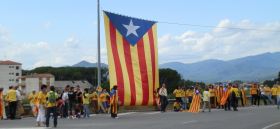 September 11th is the Catalan National day known as the Diada. Though a national day, it is more a day of commemoration, rememberance and politics than a day of celebration. The date is the anniversary of the fall of Barcelona, and so Catalonia, to the Bourbon Spanish in 1714 at the end of the War of Spanish Succession. Next year will be the 300th anniversay and in recent times the day has been marked by a great outpouring of hope and wishes for Catalan independence. Last year more than a million people were out on the streets of Barcelona. This year was marked by a linking of hand in a human chain that stretched 400km from Le Perthus in the north to the southern border with Communitat de Valencia in the South. (The photos are from the Via Catalan at Fornells, just south of Girona).
September 11th is the Catalan National day known as the Diada. Though a national day, it is more a day of commemoration, rememberance and politics than a day of celebration. The date is the anniversary of the fall of Barcelona, and so Catalonia, to the Bourbon Spanish in 1714 at the end of the War of Spanish Succession. Next year will be the 300th anniversay and in recent times the day has been marked by a great outpouring of hope and wishes for Catalan independence. Last year more than a million people were out on the streets of Barcelona. This year was marked by a linking of hand in a human chain that stretched 400km from Le Perthus in the north to the southern border with Communitat de Valencia in the South. (The photos are from the Via Catalan at Fornells, just south of Girona).
As with most people arriving in Spain, when we arrived several years ago, we weren't particularly aware of Catalan nationalism. We would have known more about the demands for Basque Country independence. If you don't know the history it can seem strange that the national day commemorates the takeover of Catalonia by Spain. Surely Catalonia was always Spanish?
The history of Catalonia is long, confusing and vanishes in parts. In many ways it is like a romantic tragedy with a people yearning for self-determination only to see it snatched away at the last instant each time. The history is also confusing, because Catalonia hasn't really been independent in its history. It has always been intertwined with Spain in one way or another.
The modern independence movement and Catalan history as taught in schools idealises the great flowering of Catalonia between its formation in around 700 as a march (a semi-autonomous border territory) between the Franks and Moors of Spain, and its high point in the middle of the fourteenth century when Catalans controlled territories across the Mediterranean all the way to Athens.
 However, as modern Spain grew out of the amalgamation of the Spanish kingdoms and principalities via the unions by marriage of the various kings and queens, Catalonia slowly became marginalised, though it maintained its own governance and laws as the kingdoms within Spain kept to a loose federal structure. For instance, Catalonia had its own parliament from 1057 - the oldest in Europe and 200 years early than England and kings had to present themselves to the Catalans to be legitimised.
However, as modern Spain grew out of the amalgamation of the Spanish kingdoms and principalities via the unions by marriage of the various kings and queens, Catalonia slowly became marginalised, though it maintained its own governance and laws as the kingdoms within Spain kept to a loose federal structure. For instance, Catalonia had its own parliament from 1057 - the oldest in Europe and 200 years early than England and kings had to present themselves to the Catalans to be legitimised.
As the kingdoms coallesced in the thirteenth and fourteenth century's, Catalonia's rulling family married into the kingdom of Aragon and became the kings of a united Aragon (Aragon was a kingdom, with Catalonia was a collection of Duchy's and the principality of Girona). The empire claimed for Catalonia is more properly the Aragon empire. Around the end of the fourteenth century and the beginning of the fifteenth century, Catalonia started to struggle and began to lose influence. The black death decimated the population and the crown and court started to become entwined with the larger neighbouring kingdom of Castille. Catalonia went through an economic crisis followed by a civil war (1462-1472) which vastly diminished Catalonia's political power and allowed the burgeoning French kingdom to interfere both wooing and betraying different Catalan interests.
The result was that though Spain discovered America in 1492 with the consequent riches the Spanish empire brought, the rights to trade in America were restricted to the Castillans who only licensed trade ships from Cadiz and the ports in the north. Spain was growing rich, but for Catalonia it was a time of hardship and kowtowing to the dominant Castillans (known as La Decadencia and skipped over in much of Catalan history). And while Spanish Galleons were reaping their bounty in the Americas, the Catalan coast was being raided by Barbary Pirates - more strictly Corsairs agents of and supported by the Ottoman empire out of Constantinople the dominant force in the Mediterranean.
The Spanish empire continued to flourish through marriage leading to Holy Roman Emperor Charles V becoming Carles I of Spain (1516) bringing his northern European dominions in the Low Countries into the Spanish fold so countries like the Netherlands became a Spanish territory for instance. Spain was the first worldwide empire on which the 'sun never sets', but Catalonia was still just a marginal outpost. And then the military expense of wars and battles to stave off revolts in this grand empire hit, and the empire started to disintegrate with revolts in the Netherlands and conflict with Britain and France..
Catalonia had only a marginal part in a Spain dominated by the Castillians and felt it was suffering indignities at the hands of the Spanish army leading to another uprising (the Reapers War or Catalan Revolt in 1640-52). This led to a self-proclaimed short-lived Catalan Republic in the year of 1641 under French protection. However, the French were playing their own game and in 1652 took Catalonia North, formally coming to an agreement with the Spanish in the Treaty of the Pyrenees of 1659.
The Spanish conflict with France re-emerged in the Netherlands and Germany leading Spain to look to strengthen its borders. But it did so imposing taxes on Catalonia for fortification and soldiers (which is why there are the great fortresses and ciutadellas on the French and Spanish side of the border) leading to the revolt of the Barretinas.
Stymied, broken and betrayed between the politics of the great powers of Spain and France, Catalonia had a chance for revenge in the Spanish War of Succession - a grand European struggle played out across the continent between the house of Bourbon (the French kings) and the house of Hapsburgs (of Austria and the Holy Roman Empire). The lack of an heir to Charles II of Spain who was also the Holy Roman Emperor meant Spain was caught between the two major families of Europe leading to a long and very complicated war that involved most of Europe. The British played for their own interests supporting the Hasburgs and taking possession of Menorca at one point, and eventually getting Gibraltar to accept the Bourbon king. Marlborough House outside Oxford is the direct result of the successes of the Duke of Marlborough in this war, though his part was played out in Spanish Netherlands and Germany.
 At the time of the war, despite the ups and downs in Spain's fortunes, Spain remained broadly federalised as it had since the middle ages. So when the time came to choose, the Catalans remembering the way they had been used by the French and still against the Castillians, chose to side with the Hapsburgs. Much of the rest of Spain was pro-Bourbon for Philip V a grandson of Louis XIV of France. As had happened before, Catalonia was on the wrong side and was squeezed by the power politics of its grand European neighbours. In 1714 on September 11th, the Bourbon Spanish under the control of Duke of Berwick (taking French colours - his uncle the Duke of Marlborough fought for the British-supported Hapsburgs) broke the seige of Barcelona and Catalonia was taken over by the Spanish. Not in the federated way of the past, but in a crushing takeover in an imperial style like Louis XIV had done France, centralising control and stripping away local customs and laws. Catalan institutions were closed and central Spanish control put in their place. Catalan was discouraged and Castillan Spanish promoted. Basically Catalonia was subjected to the new Spanish King's will. This is the reason for the Diada.
At the time of the war, despite the ups and downs in Spain's fortunes, Spain remained broadly federalised as it had since the middle ages. So when the time came to choose, the Catalans remembering the way they had been used by the French and still against the Castillians, chose to side with the Hapsburgs. Much of the rest of Spain was pro-Bourbon for Philip V a grandson of Louis XIV of France. As had happened before, Catalonia was on the wrong side and was squeezed by the power politics of its grand European neighbours. In 1714 on September 11th, the Bourbon Spanish under the control of Duke of Berwick (taking French colours - his uncle the Duke of Marlborough fought for the British-supported Hapsburgs) broke the seige of Barcelona and Catalonia was taken over by the Spanish. Not in the federated way of the past, but in a crushing takeover in an imperial style like Louis XIV had done France, centralising control and stripping away local customs and laws. Catalan institutions were closed and central Spanish control put in their place. Catalan was discouraged and Castillan Spanish promoted. Basically Catalonia was subjected to the new Spanish King's will. This is the reason for the Diada.
In the eighteenth century, across the rest of Europe great figures of the Enlightenment emerged but as with the period of La Decadencia, Catalan history disappears, subjugated by Spanish influence. Not until the 19th Century did Catalonia find its voice again during the Reneixement - a flowering of Catalan national hopes and increasing interest in the older medieval history of Catalonia.
By the start of the 20th Century Catalonia blossomed as the centre of modernism and the roots of modern art and an economic engine for Spain. And in the 1930s under the Spanish Republic, Catalans thought they could at last be independent. Hopes that were dashed by the civil war victory of Franco and his overbearing dictatorship. Catalans fled. Catalan was banned and Catalan politicians were shot. Within living memory are indviduals forced to learn in Spanish at school. And others who worked subversively to teach Catalan and keep Catalonia alive as an idea during Franco's reign.
With the return of democracy the old ideas and dreams have returned, and Catalonia seeks its chance once more. This is why 1.6m people came onto the streets to call for Catalan independence this year.
La Jonquera to Fort de Bellegarde (France)
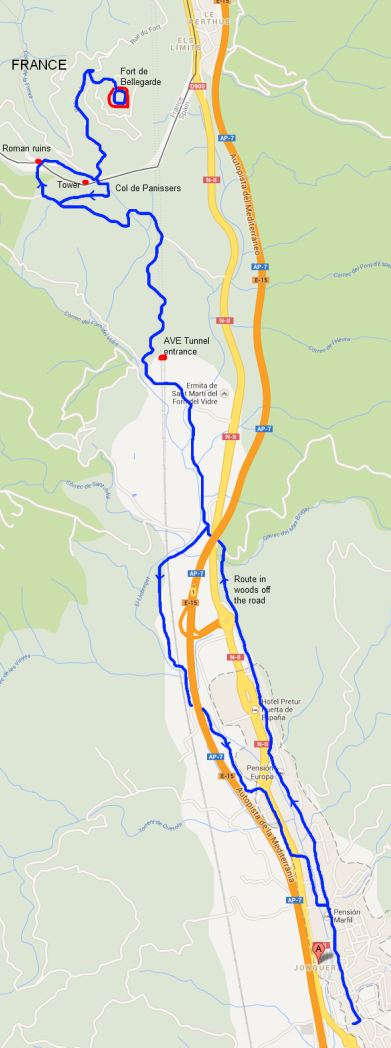 La Jonquera is a border town just below the main pass in the Pyrenees that separates France from Spain. This pass has been used for thousands of years by peoples moving between the Iberican Penisular and mainland Europe. The Roman's came this way and built the historic Via Augusta road that runs all the way through Spain down to Cadiz and links with the Via Domitia on the French side of the border.
La Jonquera is a border town just below the main pass in the Pyrenees that separates France from Spain. This pass has been used for thousands of years by peoples moving between the Iberican Penisular and mainland Europe. The Roman's came this way and built the historic Via Augusta road that runs all the way through Spain down to Cadiz and links with the Via Domitia on the French side of the border.
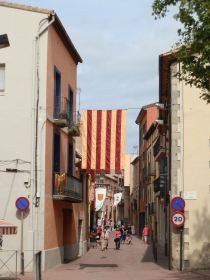
With such a long history and with such strategic importance, both sides have built castles and forts to defend the border. As you drive along the modern autoroute if you look up, you'll see Fort Bellegarde - a Vauban chateau fort built in the 1690s after France annexed Catalonia North.
The road itself was also important as it was the main route out of Spain for tens of thousands of Republican refugees fleeing Spain at the end of the Spanish Civil war. La Jonquera has the museum of exile which states that at one point La Jonquera had around 500,000 people in the town looking to flee into France.
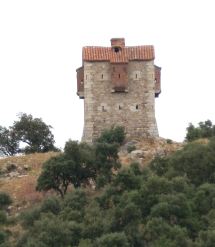
Nowadays, La Jonquera is a brash shopping area for day-trippers from France coming to stock up on perfume, wine and cigarettes at the Spanish lower tax rates, and as a truck holding stop with artic lorries from across Europe parked up to avoid the French restrictions on when truckers can be on the road. As you drive past it's not obvious that there is an older town hidden behind all the gaudy supermarkets, advertising and petrol stations.
The idea for the walk was from our children who were thrilled with the idea of walking to France (and we did take passports just in case). Despite being a Sunday, La Jonquera was busy with cross-border tourists out for a bargain and it was the Festa Major in town, so we had some difficulties parking. We eventually found space on the south side of the town, which meant we could walk through the centre to see more of the town on our way north.
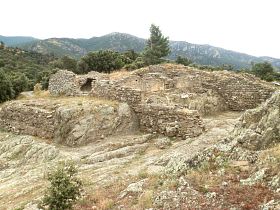 The Via Augusta route is one of those suggested on the Costabrava.org website and we were looking out for yellow-blue marking. These, together with scallop shell symbols, mark the Route of Saint James (Camino de Santiago) which connects all the way to Santiago de Compostela in Galicia. Unfortunately where we started from we couldn't find the symbol, and the marked walking routes and maps in the town tended to be more circuitous routes into the hills longer that we planned.
The Via Augusta route is one of those suggested on the Costabrava.org website and we were looking out for yellow-blue marking. These, together with scallop shell symbols, mark the Route of Saint James (Camino de Santiago) which connects all the way to Santiago de Compostela in Galicia. Unfortunately where we started from we couldn't find the symbol, and the marked walking routes and maps in the town tended to be more circuitous routes into the hills longer that we planned.
So instead we followed our nose through town. The centre had decorations up for the festival and a line of ladies making lace with needles on cushions and dozens of bobbins linking threads to make the patterns. The centre is small but has older buildings and a church and is very pleasant for a stroll. We continued through the town past the numerous clothes and souvenir shops including a big pile of mexican sombreros - something which isn't really Spanish, let alone Catalan.
Eventually we started to come out of the town and it still wasn't clear where to go. Outside the customs house, the main road split to the main motorway or the N II - neither of which we wanted to walk along, and ahead of us was an large empty expanse of concrete that presumably would have been used to hold trucks before the border was opened under Schengen. We guessed and crossed the concrete and just the other side of the last town roundabout finally saw the first yellow-blue marking. The path itself didn't seem that well used with gorse and brambles growing across the track. However, after the first stretch we crossed the NII and under the motorway and started across the fields towards the hills.
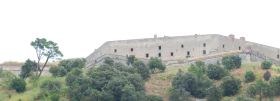 The path now ran through fields with the motorway on one side and the new AVE high speed train line on the other. At the end of the fields the path joins a road that leads up to the service buildings for the new Pyrenees train tunnel into France. Our path continued up and over the top of the tunnel following a track that climbed steeply into the woods.
The path now ran through fields with the motorway on one side and the new AVE high speed train line on the other. At the end of the fields the path joins a road that leads up to the service buildings for the new Pyrenees train tunnel into France. Our path continued up and over the top of the tunnel following a track that climbed steeply into the woods.
Last year (July 2012), a huge forest fire that burnt a stretch of woodland and forest nearly 40km long from the border back down almost to Figueres, and so much smoke that that it reached Barcelona. We drove past about a week after it happened and it looked like total devastation - with every tree seemingly caught by the fire and left as black leafless sticks as if nothing had survived. Now walking through the woods you see the resilience of the corks trees and the forests. The fire has cleaned out the undergrowth, but the woods are back to green as new plants have grown. And the cork-trees with their blackened bark are back in leaf. Foresters are clearing out the genuinely dead trees, but the thing with cork-bark is that it is a fire protection. Only the very outer part of the bark burns and as cork bark continues to grow from the inside out, slowly the damaged outer bark is rejuvinated by the bark underneath. It's the same principle that enables cork to be harvested by stripping the bark from the tree, without damaging the tree itself as the bark grows back.
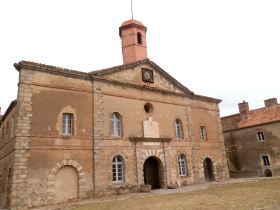 We climb steadily past large boulders and rounded weathered rocks. Ahead of us we can see the fort, but also a strange tower-house which looks like it has a face. We carry on following the marked signs up to Col de Panissers and arrive at the ruins of the Roman fort built on the col. As we look around the fort and read the description of the ruins we're not entirely sure if we've crossed the border, but we discover that the pyramid just above the ruins marks the border so we can stand one foot in Spain and one foot in France. The sign on the ruins marks the change of road from Via Augusta into Spain to Via Dolmitia into France. To the north are great views down the Vallespir valley and onwards to the plains of Roussillon and the Corbieres mountains in the distance. Behind up we have a view that looks all the way to the Montgri hills.
We climb steadily past large boulders and rounded weathered rocks. Ahead of us we can see the fort, but also a strange tower-house which looks like it has a face. We carry on following the marked signs up to Col de Panissers and arrive at the ruins of the Roman fort built on the col. As we look around the fort and read the description of the ruins we're not entirely sure if we've crossed the border, but we discover that the pyramid just above the ruins marks the border so we can stand one foot in Spain and one foot in France. The sign on the ruins marks the change of road from Via Augusta into Spain to Via Dolmitia into France. To the north are great views down the Vallespir valley and onwards to the plains of Roussillon and the Corbieres mountains in the distance. Behind up we have a view that looks all the way to the Montgri hills.
Above us is the main fort that can be seen from the autoroute - Fort de Bellegarde so we walk up to the fort itself. The fort is one of the Vauban forts like that of Villefranche de Conflent and Mont-Louis further up in the Pyrenees - a large dominant fortification built after the annexation of Catalonia north in the seventeenth century with thick walls and remparts and few comforts. It stands above the main autoroute and we can look down at the crossing point with lorries passing over the now open border. The town beneath us is Le Perthus - distinguished by being half in France and half in Spain with the border running straight down the middle of the main road.
We take the chance to explore the fort a little. Many of the rooms are now used as galleries displaying paintings and sculpture but it still feels like an indomitable castle. In the tower on one corner is a deep deep well that was the main source of water. The height of the walls and the castle's position means there are fabulous views in all directions and down to the former border, but it is a harsh building with few comforts - perhaps in keeping with it's history as a prison used by the Gestapo in the Second World War.
Though we prefer circular walks, the route back to La Jonquera mostly takes us back the same route as we came up - a slight diversion around the military cemetary links to the same path down to the top of the AVE train tunnel with views along the tracks down towards Figueres. At the bottom of the path, rather than follow the overgrown route we had discovered with difficult, we take the Pyrenees 8 Bike path along the side of the railway and motorway which is more open and rural and follows a stream back under the railway and motorway and back into La Jonquera and the mad stream of cars and people bustling around the cross-border supermarkets.
Neighbouring trips: Day trip to Villefranche-de-Conflent and Mont-Louis in France - Espolla to Rabos - Perpignan - Elne (France) - Ceret (France) - Mollo (Camprodon) Pyrenees to France - Figueres and Castell de Sant Ferran - Waterfall at Les Escaules (Boadella) - Sant Pere de Rodes - Portbou to Cerbère (France) and back - Castell de Requesens
Swimming and canoeing at Sa Tuna (Begur)
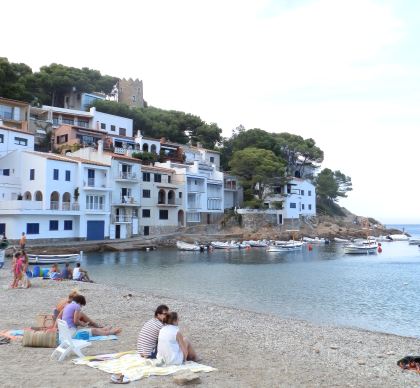 Sa Tuna is one of the three beach area connected with Begur (Sa Riera and Fornells/Platja Fondo/Aiguablava being the others).
Sa Tuna is one of the three beach area connected with Begur (Sa Riera and Fornells/Platja Fondo/Aiguablava being the others).
Sa Tuna itself is at the back of Begur around the Circumval.lacio down a 2-3km long windy road to the sea.
At Sa Tuna itself is a small hamlet of what would have been fishermen's houses sitting above a quiet bay with fishing boats, and a handful of restaurants above the main beach. Around the corner is the bay of Aiguafreda with the large hotel of Cap Sa Sal on the neighbouring headland.
The bay itself is enclosed on three sides and protected from the sea by a promentary/penisular marked with a Catalan flag that juts out into the sea on the opposite side of the bay.
The main beach sits in front of the restaurants with boat access, but once you get out into the water, you can see a second beach around to the right, accessible easily from the water, or a scramble down from the path that runs over the cliffs.
From the water itself you also see the small sea caves in the cliff walls. The beaches are pebbly rather than sand, with rocks in the bay. The natural landscape of the bay makes it perfect as an area to explore by canoe, or for diving.
Facilities at the beaches
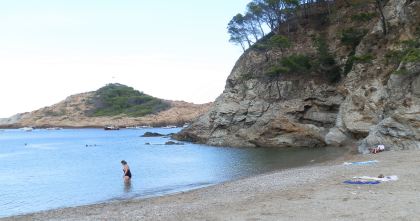 Though the beach itself is stony, it does attract holidaymakers and there is a lifeguard service and canoe hire.
Though the beach itself is stony, it does attract holidaymakers and there is a lifeguard service and canoe hire.
Directly behind the main beach are a handful of restaurant and the occasional small shop that blend in with the traditional fishing hamlet ambience. The second beach is isolated and accessible via a scramble off the path, or directly from the water.
Sand quality
It's fair to say there is little in the way of sand at the beach, it being almost all pebbles. The bay is also rocky which makes entering the water somewhat cautious and tentative when the water's chilly.
Swimming
Swimming is good with a good variety of places to explore. The boats are moored on the left-hand side looking out to sea, so though it is possible to swim around the headland to Aiguafreda (also a pebbly beach), it would mean swimming across the main boat channel.
Swimming to the right gives views of the cliffs and caves with rocks under water. Though the bay is rocky close to the shore, in the centre it tends to be a little more sandy.
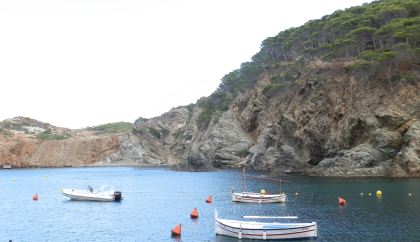 Canoeing
Canoeing
The geography with the promentary/penisular and the neighbouring bays makes this a rewarding area to explore by canoe with plenty to see in an hour or two's canoeing, particularly if you're kayaking and swimming.
The shelter of the bay gives good protection and smooth water, but if you go out around the headland, the water becomes more open and can become choppy.
Parking
Parking can be difficult as there are a limited number of places. Parking extends up the access road, and the general advice would be that if you see a space take it. Parking around the main harbour is tricky.
Walks
The GR92 runs around the Cap de Begur headland. From this beach see Sa Tuna, Cap de Begur, Begur or see Begur, Ses Negres and Sa Riera - Palafrugell, Tamariu, Begur residential and Esclanya - Masos de Pals, Begur, Sa Riera and Platja de Pals - Fornells and Aiguablava walk (GR92)
Next beaches
South to Platja Fonda (Begur) - North to Sa Riera (Begur)
Swimming and bay of St Antoni de Calonge
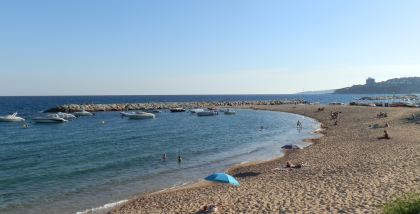 Sant Antoni de Calonge sits next door to, and is sometimes confused with, Palamos as the long sand beach links the fishing port at Palamos around the bay to the hotel and rocks at Torre Valentina.
Sant Antoni de Calonge sits next door to, and is sometimes confused with, Palamos as the long sand beach links the fishing port at Palamos around the bay to the hotel and rocks at Torre Valentina.
Although there is a traditional old heart to St Antoni, in the main the town consists of more modern apartment blocks, hotels and terraces of houses that line up 4-5 rows deep from the beach back to the main road that connects Palamos to Platja d'Aro.
The town has other areas and links to Calonge and villa estates and campsites above Torre Valentina but it has the feeling of a faintly underused purpose-built holiday area that lacks a little in character or pizzazz.
The beach area consists of a number of artificial bays protected by groynes of rocks to keep the sand from being washed away. If you're familiar with the beaches in Barcelona, this area has a very similar feel and quality.
At the back of the beach is a long promenade that would take you all the way to Palamos or round to Torre Valentina. The promenade has been recently done up (2019) and is good for a stroll. Though there are a few smaller hotels, the area is mainly residential and quiet, with a selection of bars, shops and restaurants looking out to sea.
The beaches with protection running parallel to the beach form a number of small and very sheltered bays. Some are used for mooring boats in addition to sunbathing, and because of the protection, the water keeps warmer than the open sea, and the sand shelves gently making it family friendly for smaller children.
Unfortunately that doesn't get round the artificial feel. If it was a city and the only beach it would be OK, but with so many other better Costa Brava beaches nearby, there's not really a reason to use this one.
Facilities at the beaches
The beaches have lifeguard stations and in places on the promenade at the back there are occasional shops and bars. Recently they've added a floating obstacle course (think Wipeout) for children in one of the bays.
Swimming areas are marked out with buoys. The beaches with long groynes reaching out to the sea are more open and feel more natural, with fresher water and more chance of waves.
The beaches behind the parallel rocks are warmer and more sheltered by feel much more artificial.
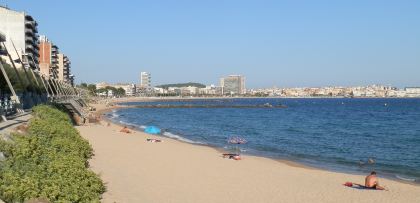
Sand quality
Sand quality varies along the beach. In parts it feels fine, in other areas it is grainy and stony.
If you do use the beach, walk along the sand to find the best areas. Even in the parts that are stony, the area at the water's edge can still have softer sand.
Swimming
The only positive benefit for swimming was the possibility of warmer water earlier or later in the season.
The bays have a sandy bottom and the odd fish can be seen, but it feels very man-made.
If you are in the direct local area, swimming across the small bays would be good exercise, but nothing to really get excited about.
Parking
There is parking at the back of Sant Antoni closer to the main road.
Walks
This is an area for pleasant passeo from Palamos to Torre Valentina rather than a mainstream walk.
Next beaches
South to Belladona and bays to Torre Valentina - North to Palamos main beach
Blanes, Lloret de Mar, Tossa de Mar by GR92
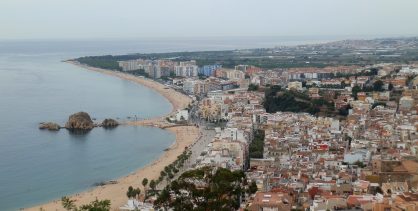 The two best known tourist towns on the Costa Brava are Lloret de Mar and Tossa de Mar - the first for its nightlife and the second for its panaroma and old walled town by the sea.
The two best known tourist towns on the Costa Brava are Lloret de Mar and Tossa de Mar - the first for its nightlife and the second for its panaroma and old walled town by the sea.
The two towns are at the southern end of the Costa Brava and are much busier and livelier than the more genteel towns that further north in central Costa Brava.
However, before we moved here, our first experience of walking in this area was travelling up by train from Barcelona to Blance on the local Barcelona train network (Rodalies) that runs up the Maresme coast.
The first time we took the 70 minute train journey up to Blanes and then made a walk to Lloret, before returning to Blanes on one of the regular Dojijet passenger boats that run schedules up and down the coast calling in at the towns and beaches.
The second time we also went by train but took the bus to Lloret from the train and then walked to Tossa, again before catching the boat back down the coast.
If you're staying in Barcelona, both options are very practical ways of seeing the start of the Costa Brava by public transport for an adventure out of the city.
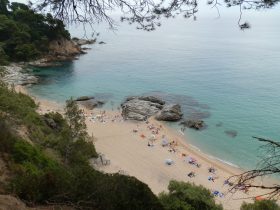 However, despite the popularity of the towns for holiday makers, we don't go to the southern towns of the Costa Brava very often. We'd be more likely to go to Girona for shopping, or to keep to the beaches closer to home than make the trip to the more southern resorts.
However, despite the popularity of the towns for holiday makers, we don't go to the southern towns of the Costa Brava very often. We'd be more likely to go to Girona for shopping, or to keep to the beaches closer to home than make the trip to the more southern resorts.
Today, however, our children have a visit to Lloret's Water World water park, to make use of the remaining 2x1 tickets they got as part of their day at Platja d'Aro's Aquadiver Park Water Park when their cousins came to visit (one ticket gives you access to both parks).
So we're getting dropped off in Blanes for the walk while everyone else splashes about on the slides of Water World, then meeting up again in Tossa (about 21km) later in the day.
It means this is a linear walk rather than circular walk that we prefer, but as mentioned, the Dofijet boats run up and down the coast, so giving you the novelty of completing the loop by sea if you want to get back to the start point.
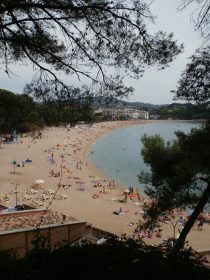 The walk starts in Blanes which is officially the start of the Costa Brava as it's the first point where you come into the rocky headlands that distinguish the Costa Brava coast.
The walk starts in Blanes which is officially the start of the Costa Brava as it's the first point where you come into the rocky headlands that distinguish the Costa Brava coast.
To the south of Blanes is the Maresme coast, a long stretch of fairly featureless beach than runs all the way to Barcelona taking in the Maresme towns of Malgrat de Mar, Santa Susanna, Pineda de Mar and Calella de la Costa (different from Calella de Palafrugell), that are often mislabelled as Costa Brava by less scrupulous tour operators.
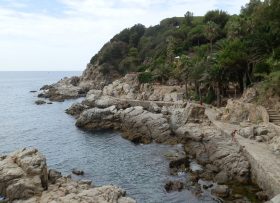 In many ways Blanes resembles the Maresme towns more than those further north.
In many ways Blanes resembles the Maresme towns more than those further north.
Streets are laid out in blocks which gives the town a more industrial type feel and it's a town more orientated towards Catalan visitors than those from overseas.
The ease of access from Barcelona means it is popular with locals, but it has far fewer non-Catalan tourists.
Reaching the sea-front after passing through the town, we're greeted by a long broad Passeig Maritim full of restaurants and bars built for people who want to take an evening passeo, but in the morning it's quite quiet.
The beach itself is very clean and looks as if it has been raked, but as the day is a little early and overcast there aren't too many sunbathers on the sand.
The beach splits in two - a long sandy Maresme-type stretch to the south, then a rocky headland (Sa Palmora) - almost the marking stone for the Costa Brava and then the first proper Costa Brava type bay (Badia de Blanes) up to the port area.
 We walk along the Passeig Maritim to the port and then realise that we've missed the turning for the GR92.
We walk along the Passeig Maritim to the port and then realise that we've missed the turning for the GR92.
When we first did this walk, several years ago, we made the same mistake and had to negotiate the roads and estates above the town to get back on track.
This time we double back but either we've missed the sign or the signposting isn't clear and we have to hunt to find the starting point, walking past the tiny church of Nostra Senyora de l'Esperanca before finding the connection at a loop at the back of Carrer Camadasa and then up a concrete stepped footpath at the back of the houses rising above the sea line.
We're heading up to the tower of Castell de Sant Joan the highpoint above the town - and the ideal site for photos.
The path between the houses runs out into a park-like area, and we run into the first proper flight of stairs.
This part of the walk is almost all stairways. I only counted the steps on the upper third of the walk (250), so my guess is that this is a climb of 600-1000 steps to reach the tower at the top - so we reached the top sweating and with slightly aching knees.
The view from tower at the top looks down across Blanes and its beaches and down along the Maresme coast across the mouth of the Todera river. To the north you can make out the villas and urbanisations around Lloret in the distance.
The popularity of this area means there are large numbers of vast urbanisations such as Aguaviva Park scattered across the hills and down to the coast, each house straining for a distant sea view.
We're not keen on urbanisations as they normally lack a centre and facilities and seem to be more a sprawling mass of holiday homes, either with dogs, or shut down in the winter.
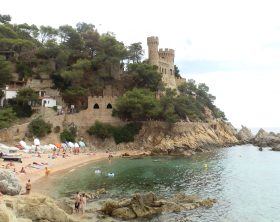 The GR92 continues past the tower and through the woods before reaching the road to Sant Cristina.
The GR92 continues past the tower and through the woods before reaching the road to Sant Cristina.
The sea is to the right, but we're walking away from the coast on the ridgeway, with the area to the right firstly more of a gated urbanisation, and then subsequently the fenced off area for the Botanical gardens of Pinya de Rosa.
It's a pity as it means we're walking on the road past houses and vilas when it would be much more rewarding to be closer to the sea, but without local knowledge and a long walk ahead of us we're not exploring to see if there are better alternatives.
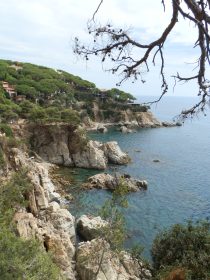 After the botanical gardens the next fenced off area is for the Hermitage of Santa Cristina with road access down to the beach of Treumal and Santa Cristina.
After the botanical gardens the next fenced off area is for the Hermitage of Santa Cristina with road access down to the beach of Treumal and Santa Cristina.
Since we're aiming for a long walk we don't take the diversion down to the beach. If we were exploring more we'd look to see if there were other routes closer to the coast as the GR92 is proving a little disappointing at this point between Blanes and Lloret.
Finally we find a route off the road and down towards the Platja de Boadella.
We're in trees and can see the coast with the sandy unspoilt beach below us which looks as if it is popular with naturists.
The GR92 now connects with the Jardins de Santa Clotilde at the outskirts of Lloret. The GR92 runs around the outside, but as we go past the other side, we realilse we could have gone through the gardens for a small fee.
Just the other side of the gardens the GR92 is back on the road at Fenals, but we quickly dip back into the woods above Platja de Fenals - Lloret's second (and quieter) beach.
There's a headland over the beach with views back down the coast towards Blanes.
We walk along the back of Fenals beach which is full of children and families. In the bay someone is parascending being towed by a speed boat.
 Around the other side of the bay it looks like the path should pass through a tunnel to the next headland, but the tunnel has been closed by a rock fall (probably from some time ago) so we have to double back and find the GR92 marked near the souvenir shops at the end of the beach.
Around the other side of the bay it looks like the path should pass through a tunnel to the next headland, but the tunnel has been closed by a rock fall (probably from some time ago) so we have to double back and find the GR92 marked near the souvenir shops at the end of the beach.
It would be easy just to follow the road directly to Lloret, but the GR92's red and white flashes actually take us to the back of a small park and up a flight of steps heading back to the sea.
At the top we continue straight on to reach a watch-tower on the cliffs above the coast. This is another tower called Sant Joan and a twin to the one above Blanes.
The path now takes steps down towards the sea through the rocks and through what seems to be the middle of a bar/restaurant down into the rock pools of Cala Banys - there's no beach here but lots of places to scramble.
We also notice that it's starting to get busier with lots of tourists around and we can make out other languages including Russian (the Costa Brava is proving very popular with East Europeans).
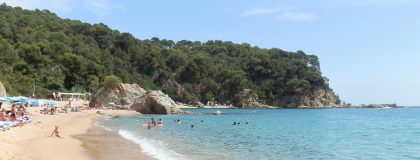 Around the headland from Cala Banys we get the first sight of Lloret's beach and the town itself.
Around the headland from Cala Banys we get the first sight of Lloret's beach and the town itself.
Lloret's main beach is long with a castle at the far end from where we're standing.
There are lots of people on the beach and swimming and dotted along the beach front are numerous stalls offering water-based attractions like jetskiing, or boat trips.
Around Lloret the hills are full of urbanisations with holiday villas and houses that can be seen from the rocky end of the beach. We're not here to visit the town, but Lloret is the busiest and liveliest town on the Costa Brava and very popular with young people from across Europe looking for bars and clubs.
Outside the main season though, its actually still popular with Catalans and walking in winter we'd find retired Catalan folk enjoying the town.
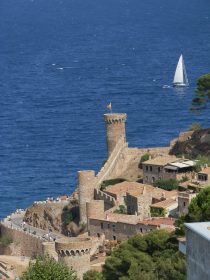 Instead we walk along the promenade at the top of the beach around to the castle.
Instead we walk along the promenade at the top of the beach around to the castle.
There are numerous bars, hotels and restaurants selling cheap food like burgers and pizzas, but the sea front buildings are only about 7-8 storeys high so it doesn't feel over-built in the way other package holiday towns like Benidorm can feel (though, as ever with Costa Brava towns, there is one over-sized edificio).
With the people and the scenery it's not an unpleasant beach to walk along.
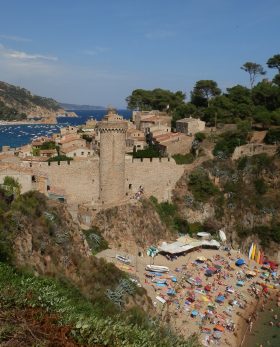 We reach the far end of the beach under the castle (Castell d'En Plaja) - a mock castle built in the 1930-40s.
We reach the far end of the beach under the castle (Castell d'En Plaja) - a mock castle built in the 1930-40s.
The beach at the far end is rocky again and a small islet just in the sea beyond the holidaymakers is full of cormorants enjoying the sea.
The path curls around the base of the castle and round to the next bay. Suddenly Lloret is behind us and we're back to a more regular Costa Brava scene with a rocky bay and pebbly beach beneath us.
We still have tourists around, though after another set of steps up, the tourist numbers drop off as we round to the next bay a small sandy beach of Cala Trons with a handful of holiday makers in the water.
We try to continue on the path, but the route is closed for Cala Tortuga, so instead we have to double back and take the road through the urbanisation meeting the GR92 again as it returns to follow estate roads - so yet more tarmac.
The sun has also come out so it's starting to get hot and dry - one of the challenges of walking in August - we've brought water but it's going fast.
The path curves up and around the urbanisation and then down towards Canyelles past more villas with sea views and mature gardens.
The road runs past the urbanisation centre - little more than a diving centre, an restaurant and an estate agent - urbanisations always seem to have minimal facilities and then turns down to the beach.
The red-white flashes are easy to follow, and we turn left just before a tunnel and go right down to the sand.
Platja de Canyelles has a small marina on one side and a sandy beach divided into one main beach and a couple of smaller coves.
It's a very pretty beach, but relatively quiet, and would be somewhere to visit as an alternative when Lloret is too busy.
We refill with water and I dip my hat in the shower to cool down as the day is now getting properly hot.
 The walk out from Canyelles is all up hill and still largely road and estate houses.
The walk out from Canyelles is all up hill and still largely road and estate houses.
Eventually the road turns into a track through the woods at the back of the next urbanisation.
It's dusty and there's not that much to see. it would be nice to reach Cala Llorell - the next bay, but the GR92 skirts round the fences at the back of the estate and it's not clear if it's because the beach or urbanisation is private or because the geography prevents the path getting down to sea level again.
Instead we're heading up and over the top of the urbanisation - the fence always to our right and little to see, and when we reach the top, the main Lloret-Tossa road in earshot (but not visible).
We continue around the top of the estate and start to see the hills at the back of Tossa de Mar.
The GR92 runs along the road for a while before turning off to the right along a ridge way through the woods towards Tossa.
 As we get closer to Tossa de Mar we decide to take the Cami de Ronda to the town rather than the GR92 as the GR92 runs through the back a little, while the Cami de Ronda runs around the cliffs and then down to the old walled town.
As we get closer to Tossa de Mar we decide to take the Cami de Ronda to the town rather than the GR92 as the GR92 runs through the back a little, while the Cami de Ronda runs around the cliffs and then down to the old walled town.
Suddenly we can see the sea again from the tops of the cliffs and Tossa comes into view.
Tossa itself is one of the most picturesque towns in the Costa Brava. The old town is walled and fortified - like Carcassonne by the sea - and stands above the sea on a peninsular with beaches on two sides.
The modern town and beach sits below the castle walls and are full of good quality restaurants and hotels. It's very popular, but whereas Lloret is more for younger people, Tossa feels more refined and middle aged.
As we walk down the cliffs we see the first turrets of the fortified old town and the houses in the middle with boats in the bay in the background. Beneath us, people are swimming in the turquoise sea of Platja d'Es Codolar, clear enough to see to the bottom beneath them.
We walk down and past the restaurants outside the old town walls.We'd visit more but we've been before and the walk has been tiring and we have a lift to meet.
On the other side of the old town we return to the main beach and walk all the way along to Tossa's third beach (La Mar Menuda)
Though we've walked this before I think our expectations have changed from the first times we walked this way out of Barcelona. In all, it was a little disappointing - the GR92 is normally a reliable high quality interesting route.
Perhaps surprisingly the coastal areas around Lloret were the best walking. Elsewhere there were simply too many fences and estates and just too much tarmac - probably about 70% of the walk was on the road.
In particular the area to the south of Tossa is particularly frustrating and obviously on a longer distance walk we don't have time to explore so much.
The next time we return we'd want to look for more local alternatives to the GR92 that take us closer to the sea - so shorter distances and not trying to link the towns.
Neighbouring walks: Platja Sant Pol to Sant Feliu de Guixols - Tossa de Mar north to Cala Pola - Tossa de Mar to Cala Llorell - Sant Grau and Cadiretes near Tossa de Mar - Cala de Sant Francesc (Blanes) - Lloret de Mar to Sant Pere del Bosc
And more details on the stretch between Sant Cristina and Lloret de Mar: Lloret's Platja de Boadella, Platja de Santa Cristina and The Fence
Swimming and beach: Swimming and beaches of Tossa de Mar - Swimming and beach at Fenals, Lloret de Mar
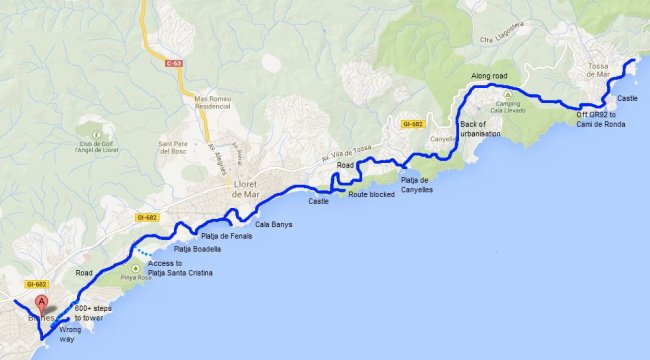
Verges, Tallada d'Emporda and Maranya
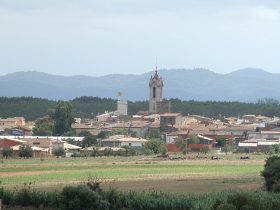 Normally the weather holds out until the first weeks of September, but this year it seems that the first overcast days have arrived in late August. With the change of weather we decided to go back into the countryside for walking, this time from Verges towards the hills of Castellar at the back. This is an area not so far from L'Escala.
Normally the weather holds out until the first weeks of September, but this year it seems that the first overcast days have arrived in late August. With the change of weather we decided to go back into the countryside for walking, this time from Verges towards the hills of Castellar at the back. This is an area not so far from L'Escala.
We last visited Verges for the Dance of the Dead (Verges - Dansa de la Mort) which takes place in Easter week, but it was more to see the procession than to see the town. This time we're in daylight so can explore a little further afield.
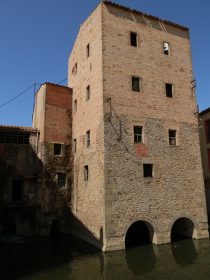 Verges itself is a small village that acts as a junction point for cars coming from the north going either to Torroella de Montgri, or continuing south to La Bisbal and then to Palafrugell or Palamos - so it has a sense of being something of a transit town.
Verges itself is a small village that acts as a junction point for cars coming from the north going either to Torroella de Montgri, or continuing south to La Bisbal and then to Palafrugell or Palamos - so it has a sense of being something of a transit town.
We park just up by the football field and then walk back down to the village. In an open space just next to the junction for the two routes, a small flea market has set up and we walk around the stalls bewildered to see rusty saws and old glass drinks bottles for sale in amongst the older furniture and book collections.
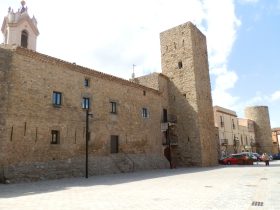 We walk down the road in the direction of La Bisbal to see an old water mill that we often see on the way up to Figueres. Verges sits just above the river Ter, which is a broad river which always has water and is navigable by kayak or canoe (hire point at Colomers, two villages along the river from Verges) and Verges itself has a small stream that runs around the village before passing underneath the disused mill.
We walk down the road in the direction of La Bisbal to see an old water mill that we often see on the way up to Figueres. Verges sits just above the river Ter, which is a broad river which always has water and is navigable by kayak or canoe (hire point at Colomers, two villages along the river from Verges) and Verges itself has a small stream that runs around the village before passing underneath the disused mill.
Following the road around the back we can see the stream which almost looks like a moat protecting the central houses with small bridges across the water to reach the gardens. We turn up across the stream and enter the main village part and head towards the church. The church tower always looks impressive and well cared for from a distance, In the main square is an old castle-like structure - a big stone building with a tower but despite Verges fame, the rest of the houses and streets in the town are rather plain and drab and without the darkness or candle light, the village lacks much in the way of charm.
Leaving the centre we head back towards the football field where we take the right hand fork (marked as a health route) to the fields and on towards a farm. Some times walking through fields feels delightful with crops growing, fertility and butterflies and insectts. In this case, he ground is flat but rough and feels unkempt. It's not helped by the small drainage ditch to the left of us which had been filled by the recent rain, and is now smelling as it dries out again. We walk past a number of cheaply-made red-brick farm buildings which seem to be the norm for this area.
 We continue across the landscape in a sullen plod and turn towards Tallada d'Emporda. In the background we can see the Castle of Montgri and in the distance the hill at Montgo near L'Escala but the it feels uninspiring. As we reach Tallada d'Emporda there are series of newer buildings as we enter the village and we can see the clock on the church, just above the bells. We navigate the backstreets and find the church besides the castle in a medieval area strangely away from the village centre. An old farm sits in what would have been the castle forecourt with a barn in the same roughly laid red bricks style which looks so tatty. The area is being refurbished so this might not be totally fair, but at the moment the area feels uncared for.
We continue across the landscape in a sullen plod and turn towards Tallada d'Emporda. In the background we can see the Castle of Montgri and in the distance the hill at Montgo near L'Escala but the it feels uninspiring. As we reach Tallada d'Emporda there are series of newer buildings as we enter the village and we can see the clock on the church, just above the bells. We navigate the backstreets and find the church besides the castle in a medieval area strangely away from the village centre. An old farm sits in what would have been the castle forecourt with a barn in the same roughly laid red bricks style which looks so tatty. The area is being refurbished so this might not be totally fair, but at the moment the area feels uncared for.
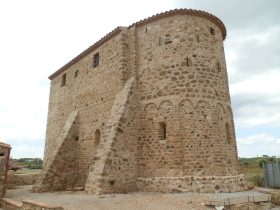 We have the option of continuing to Tor or going up directly to Maranya. As you might be able to tell, we're not finding the walk so attractive so we decide to go directly to Maranya and up towards the hills of Maranya. We're definitely in pig farm country and numerous low red brick buildings dot the fields or sit along side the path.
We have the option of continuing to Tor or going up directly to Maranya. As you might be able to tell, we're not finding the walk so attractive so we decide to go directly to Maranya and up towards the hills of Maranya. We're definitely in pig farm country and numerous low red brick buildings dot the fields or sit along side the path.
Maranya is a hamlet on the fringes of the hills and has good views to the distance and down towards Verges. Behind the hamlet into the hills, the vegetation changes more to trees and low scrub with broad tracks. We take a break at the very well restored chapel at the top of the village, then rather than continue into the scrub, we take the path down and start heading back.
It's peaceful and rabbits sit on the track in front of us, before darting into great sandy burrows to the right of the path. We turn left and head through a small wood full of pine scent before zig-zagging our way back down to Verges slightly disappointed by the walk and the area.
Neighbouring walks: Colomers and Jafre - Vilopriu and Valldavia - Serra de Daro, Fonolleres, Sant Iscle d'Emporda - Verges - Dansa de la Mort - La Pera, Pubol and around - Bellcaire d'Emporda, Tor and Albons - Rupia and Foixa
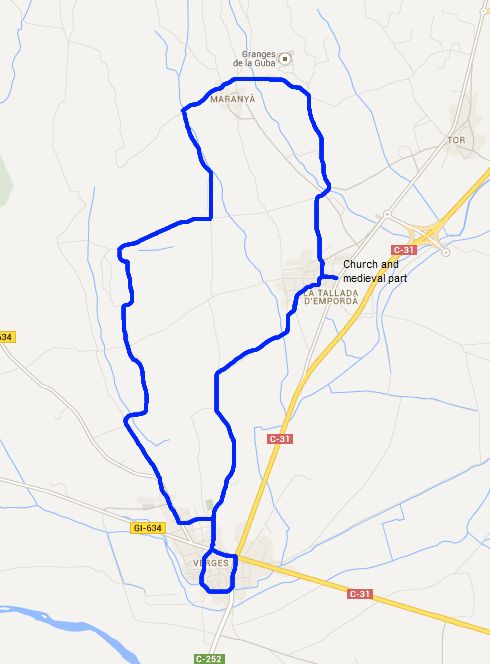
Beach at Platja de Castell - swimming and canoeing
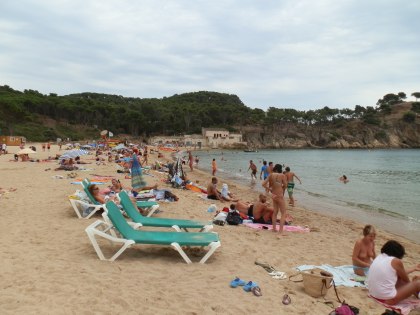 Platja de Castell is a very large unspoilt sandy beach situated just to the north of Palamos La Fosca. It's unusual in that for such a large beach it is actually in a protected area so there is no development allowed. It also marks the start of the set of wild beaches and bays that run up to Cap Roig and Calella de Palafrugell and as a result it is very popular as a starting point for canoeing up the coast.
Platja de Castell is a very large unspoilt sandy beach situated just to the north of Palamos La Fosca. It's unusual in that for such a large beach it is actually in a protected area so there is no development allowed. It also marks the start of the set of wild beaches and bays that run up to Cap Roig and Calella de Palafrugell and as a result it is very popular as a starting point for canoeing up the coast.
The beach itself sits underneath an Iberic village on the cliffs to the left and has two older houses at either end but otherwise is completely natural. The woods and paths to the north lead to other secluded bays and beaches and in the forest you can find an artist studio/hut built specially for Salvador Dali. The beach has been used for filming and appears in a number of Spanish films.
The area to the right side, immediately below the pink house, and behind the last set of rocks is often used by naturists. Generally they can't be seen unless you specifically climb the rocks or swim over to the bay in that direction.
Facilities at the beaches
Though the beach is unspoilt, it does benefit from chiringuitos (beach-bars) on the beach, temporary toilets and a canoe hire service (to the left). Normally in the height of summer there are yachts and motor boats anchored in the bay outside the swimming line. At the back of the beach is an informal picnic area under the trees and a large seasonal car park is created every summer in the fields at the back with access from the C-31 dual carriageway. Parking is €5 per day until about 17.00 in the afternoon.
The Benelux Campsite is located about 1km away on the beach access road close by to Hotel Malcontent five-star hotel. The beach is connected to the Ruta del Tren Petit cycle paths and there is a lot of cycling and walking nearby.
Sand quality
The sand is soft and good quality in the main, but storms this year (2015) mean that entering the water now has pebbles and shingle for the right hand side of the beach. The left side closer to the cliffs of the Iberic village is softer.
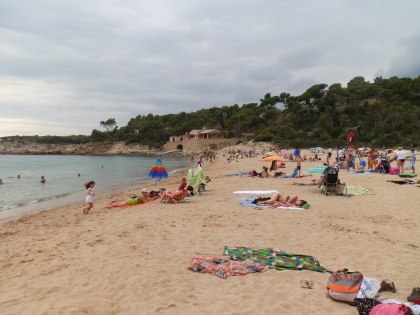 Swimming
Swimming
The bay is broad and quite open and one day can be smooth as a millpond, then the next have metre high waves. If the wind is blowing or the waves are coming, then the area under the cliffs to the left hand side tends to be quite sheltered and calm even on rough days. This is also the area best for snorkeling, seeing fish and exploring with a small sea cave under the cliffs.
The left hand side also shelves most gently into the water. Having said that, the main beach areas also has a quite gentle shelving and it's popular with families.
For long distance swims across the bay is fine, though there can be a chop from the sea-ward side. Alternatively swimming out close to the cliffs on the left will also give a good swimming distance. On the right, there are also rocks and snorkelling with the next bay of Cala S'Alguer around the headland (not swum this).
Canoeing
Castell is an excellent option for canoeing and kayaks can be hired on the beach or brought through to the beach from the car park (it's a long carry though). Even if you do it for a short time, there is a lot to explore. In particular, immediately around the corner of the left hand cliff under the Iberic village is a hidden bay only accessible by boat with sea-caves and tunnels you can paddle through.
Further on are the bays of Cala de Senia and Cala Estreta which are more isolated wild beaches with sandy beaches and rocky bays, but excellent for seeing fish. We've kayaked all the way from Castell to Llafranc taking about 2.5 hours one way including a stop in El Crit. It could be done more slowly exploring more of the caves and islets. Outside the shelter of the bays, if the wind is blowing, the sea can be choppy and in some of the quieter bays you will have to look out for rocks beneath you, but it's a marvellous way to explore the coast as many parts of the Castell-Cap Roig natural area are only accessible from sea.
To the right, an easy canoe is towards La Fosca through the bay of Cala s'Alguer a very pretty, and much photographed, run of fishermen's houses on a pebbly beach with a bay dotted with rocky islets.
Parking
Parking is easy with a temporary seasonal car park at the back of the beach which costs €5 per day.
Walks
This is one of the best areas for walking with the GR92 through the protected area of Castell-Cap Roig and the wild beaches of this area, or following the headland path to La Fosca.
For walks see: Calella de Palafrugell/Cap Roig to Castell - classic wild Costa Brava - Platja de Castell and La Fosca
For cycling see: Eulogy to the Ruta del Tren Petit (Palafrugell, Palamos, Mont-ras and Vall-llobrega)
Next beaches
South to La Fosca, Palamos - North to Cala Estreta and wild beaches to El Crit and Cap Roig
Swimming at the beach of Sa Conca (S'Agaro)
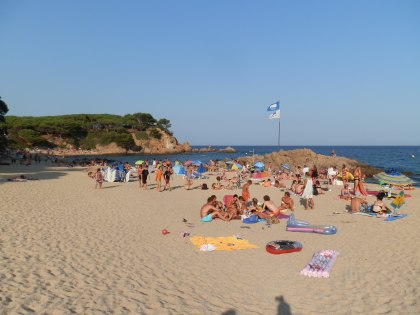 Sa Conca is a large sandy beach located between the port-marina of Platja d'Aro and S'Agaro that nestles below the luxury housing estates of S'Agaro. The estates are gated and there are no direct hotels nearby, which means that despite the size of Sa Conca's beach, it's relatively uncrowded and very unspoilt.
Sa Conca is a large sandy beach located between the port-marina of Platja d'Aro and S'Agaro that nestles below the luxury housing estates of S'Agaro. The estates are gated and there are no direct hotels nearby, which means that despite the size of Sa Conca's beach, it's relatively uncrowded and very unspoilt.
The beach is broad and sandy with rocky areas at each side. The left side (looking out to sea) has a rockier bay and more fish. The main central part of the beach is sandier. As we were visiting in the evening, one thing we noticed is that it holds the sun for a long time as there are no cliffs or high rise buildings behind the beach.
Facilities at the beaches
The beach has mostly houses at the back and a couple of chiriguitos (beach bars on the sand). There are lifeguards on station and the bay is marked out for swimming. When we were there there was a large blue swimming plaftorm of the type seen in Platja d'Aro in the main bay area. The back of the beach has a large car park which we didn't use so I'm not sure how it is accessed.
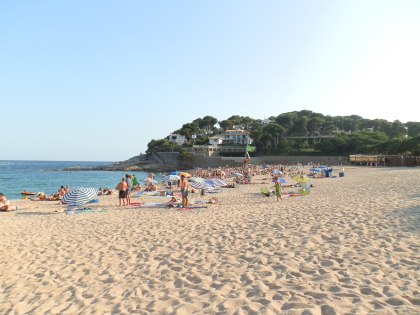 Sand quality
Sand quality
The sand is coarse to gritty under foot and a little dusty away from the sea, though there is finer and softer sand at the two ends of the beach.
Swimming
The beach shelves gently at the left and right extremes and near the rocks making it suitable for younger children. In the main area it shelves more quickly, but not as rapidly as say Platja d'Aro main beach. The rockier area to the left has a mix of submerged rocks and a sandy bottom. It's easy to enter the water along a sand channel without hurting your feet, though you do need to be aware of where the rocks are close to the surface.
The bay is broad which makes it suitable for long swims with clear water (when we were there we also saw one of the water cleaning boats that removes any stray items floating in the water). The swimming platform also makes swimming fun for older children as they can dive and jump into the w
Parking
There is parking at the back of the beach, but we're not sure where the access point is through S'Agaro. We parked higher up in the estate on one of the streets (for free) and walked down, or an alternative would be to park near the Port and walk across the final headland and down.
Walks
The GR92 continues along past the beach and around the S'Agaro headland to Sant Pol.
For walks see: Platja d'Aro and S'Agaro
Next beaches
South to Sant Pol (Sant Feliu de Guixols) - North to Platja d'Aro
Swimming at beaches between Platja d'Aro and Sant Antoni de Calonge
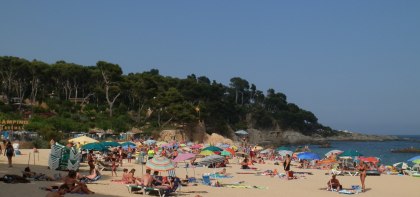 Between Platja d'Aro and Sant Antoni de Calonge (Torre Valentina) - both popular package holiday resorts - the main road runs past a number of four and five star hotels and several large campsites (International de Calonge, Treumal, Camping Cala GoGo).
Between Platja d'Aro and Sant Antoni de Calonge (Torre Valentina) - both popular package holiday resorts - the main road runs past a number of four and five star hotels and several large campsites (International de Calonge, Treumal, Camping Cala GoGo).
From the road, the area itself just looks like a connecting route as it's not possible to see the coast directly from the road. However, if you stop get out of the car and walk down one of the many stairways between the buildings, you'll find a series of small coves and bays down under the cliffs.
These include the large beaches of Platja de les Torretes below Treumal and International de Calonge (under the wooden footbridge), and further down Platja de Bella-dona behind Hotel Cap Roig (four star), Hotel Sant Jordi (four star) and Hotel de les Pis (five star).
Further small bays and beaches continue to the south before reaching the main Platja d'Aro beach - these will be added later.
Platja de les Torretes is a broad beach with some rocky areas to the north and south and behind it are the fringes of the campsites directly on the beach.
Being close to the campsites many of those using the beach are Dutch and French campers.
The bay is open but flanked by villas on the cliffs above the beach to either side giving the beach a sense of privacy and sheltering it from the breeze.
 Platja de Bella-dona is a much-photographed, but much smaller beach with a large red rock island at one end (Cap Roig, though not the same as Cap Roig at Calella de Palafrugell).
Platja de Bella-dona is a much-photographed, but much smaller beach with a large red rock island at one end (Cap Roig, though not the same as Cap Roig at Calella de Palafrugell).
The beach is divided in two via a short flight of stairs over a relatively small headland. These two half beaches are easily connected in the water though with a rocky bay with small islands.
This is an area we walked in spring but the GR92 was closed in places making connections between the bays difficult. Unfortunately the GR92 remains blocked between Platja de les Torretes and Platja de Bella-dona.
Facilities at the beaches
Platja de les Torettes with the campsites behind has a small restaurant at the back and direct connection with Treumal.
When we visited it was possible to go out on a banana boat into the bay. The bay itself is marked off and there are pedalos for hire.
Platja de Bella-dona is more discreet. There is a chiringuito on the southern half of the beach, but few other facilties.
To reach this beach it's a long set of steps down from the road above and you have to find the cut through between the buildings.
The bay is much rockier (and so more interesting) and good for long distance swimming.
The bay with its islands has quite a number of rocks close to the surface, so you will need to wear goggles to navigate.
 Sand quality
Sand quality
The sand is on both beaches is coarse but not quite stony, but not really sandcastle type sand.
Platja de les Torretes is all sand even into the water and was being used for casual holiday-maker type beach volleyball.
Platja de Bella-dona also has coarse sand, but depending on where you enter the water you may find a line of pebbles and rocks, so you may need to walk along the beach to find the best entry point.
Swimming
The bay at Platja de les Torretes is broad and open and shelves quite quickly. The water was clear in general, but a wind had washed some flotsam down towards the rocky parts to the left looking to the sea. Obviously this would depend on the day. Swimming it was a broad sandy bay but not particularly special.
Platja de Bella-dona was completely different. The swimming was spectacular as the bay is practically all rocks and there are small islands to explore and plenty of fish.
Entering the water you first come on a flat piece of rock - it looks like sand then you step on it and realise it's hard and slippy. Out in the bay are more rocks and crevices and it is perfect for snorkling, or for longer distance swimming between the two halfs of the beach.
The one difficulty is that at times the rocks get close to the surface so you do need to be aware of where things are under the water. It can be painful if you stop to tread water then kick a rock you haven't seen,
Parking
Parking can be problematic.
Many of the beach-goers for Platja de les Torretes come directly from the campsites. For other visitors there can be parking at the bottom part of the wooden footbridge that connects Calonge International to the beach, or parking further down just above the service station.
Platja de Bella-dona has some parking on the other side of the road to the hotels or into the estate above this, but it can be tricky at the peak periods.
Walks
All these beaches are on the GR92 and it is a favourite walk in some hiking guidebooks, but as mentioned above the path remains closed in places which means the occasional link up to the road at the top to avoid the blocakage. It's not a long walk from the main strip at Platja d'Aro (there are buses too).
For walks see: St Antoni de Calonge, Torre Valentina to Platja d'Aro (almost)
Next beaches
South to Platja d'Aro (Cala Rovira to be added) - North to Sant Antoni de Calonge
Swimming and beach at Platja d'Aro
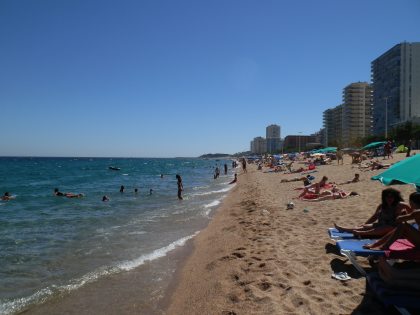 Platja d'Aro (sometimes written by tourists as Playa d'Aro in the Spanish translation of the Catalan name), is a classic package holiday type beach-side town resort on the Costa Brava at the end of the Aro valley.
Platja d'Aro (sometimes written by tourists as Playa d'Aro in the Spanish translation of the Catalan name), is a classic package holiday type beach-side town resort on the Costa Brava at the end of the Aro valley.
The town consists of a number of high rise buildings and hotels running along a broad long beach, backed onto by a main street full of shops, bars and restaurants.
Further in the back are a children's attraction park and a large water park and large estates of villas and holiday homes.
The town is popular with Dutch, German and Spanish tourists (very little sign of English about).
For locals Platja d'Aro is a main shopping area as it has main Spanish high-street chains like Zara and Mango and a large retail park.
Though it is a classic package holiday type resort, it is smaller and more refined and family friendly than Lloret or more infamous beach resorts on the Spanish Costas like Benidorm.
The whole town sits on a wide and open bay with a long wide beach. At the northern end of the beach, are a series of rocky bays around to Torre Valentina. At the south end is a port marina but there's about 4-5km between the two all of which counts as the Platja Gran.
The area being open, can suffer a little from wind but this doesn't seem to detract from sunbathers.
Facilities at the beaches
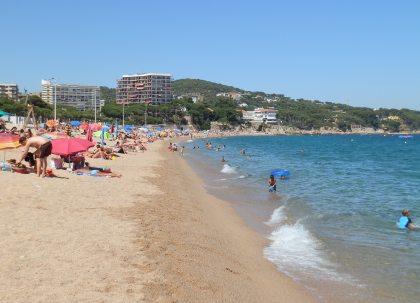 The beach has bars, shops and restaurants directly behind it at the feet of the high rise apartment blocks and hotels. In front of these shops and restaurants is a long pedestrian avenue for taking a passeo. This avenue has a number of fountains, statues and water features and is well cared for.
The beach has bars, shops and restaurants directly behind it at the feet of the high rise apartment blocks and hotels. In front of these shops and restaurants is a long pedestrian avenue for taking a passeo. This avenue has a number of fountains, statues and water features and is well cared for.
The beach is long and wooden tracks run down from the avenue towards the water at various points. There are also regular shower points and lifeguard stations. Like many bigger beaches, it has a banana-boat attraction - a long sit-on inflatable pulled by a motor boat until everyone falls off.
The bay is marked off for swimmers quite a long way out. And in summer floating islands are put up in the water as platforms to swim out to (about 30-40m out from the side). There is a platform about every 350m.
A boat picking up flotsam that might have blown into the sea regularly runs through the water keeping the water clean.
Sand quality
The sand is not great. It's gritty made up of small pea or rice-sized stones and though not painful underfoot it's not a classic beach-sand experience.
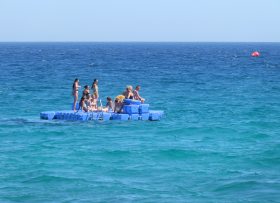 Swimming
Swimming
For such a large beach, the water is very clear. However the beach shelves deeply so you are out of your depth in a matter of a few metres.
With the water being cleaned regularly it's quite pleasant to swim, though being open it can become wavy quickly.
The swimming platforms offer good targets for long distance swimming.
Though the water is clear, the bay is sandy at the bottom and though there are occasional fish to be seen, it's not the best beach for snorkelling.
Parking
There is plenty of parking in town with a number of large town car parks behind the main shopping streets. Some are pay-for parking, but the main market car park just beyond Bonpreu, a little walk to the beach, is free.
Walks
Platja d'Aro is mainly for shopping and passeos. It is possible to walk to S'Agaro to the south or Torre Valentina to the north or out to Castell d'Aro along the river valley. However you'd probably want to start closer to get off the main strip first.
For walks see: Platja d'Aro and S'Agaro
Next beaches
South to Sa Conca, S'Agaro - North to Belladona and bays to Torre Valentina (Cala Rovira to be added)
Swimming at Platja de Pals and Platja Illa Roja
 Platja de Pals is a reasonably large community of houses and villas located at the sea about 4km down from the historic Pals village itself. It's one of the most seasonal areas on the Costa Brava.
Platja de Pals is a reasonably large community of houses and villas located at the sea about 4km down from the historic Pals village itself. It's one of the most seasonal areas on the Costa Brava.
In summer the houses and villas fill up, parking spaces can be something of a premium and there is a huge bustle around the many bars and restaurants in the area and children's amusements on the beach. In winter by contrast it feels empty with driftwood the only thing you might see on the beach.
The Platja itself is very long and broad, running all the way to L'Estartit about 10km to the north past a number of campsites on the beach and a golfing complex.
To sea are views out to the Isles Medes and down to the headland of Begur just around from Sa Riera. On a clear day you can see all the way to the hills around Cap de Creus in the Roses area.
Being broad and open, the main beach (Platja Gran) can become windy. The area is popular with kitesurfers and windsurfers away from the sunbathers.
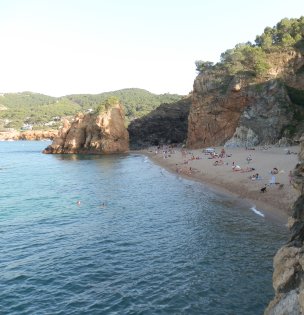 To the right as you look at the sea are a series of rocks sloping down into the sea.
To the right as you look at the sea are a series of rocks sloping down into the sea.
On a busy day there will be a steady stream of people taking the path around the corner to the bay of Isla Roja a small beach tucked under a large red rock island that is used by naturists. This path runs over the top of the cliffs behind this island to reach Sa Riera.
The beach is very pretty but the cliffs behind does mean it loses the sun in the evening quite early. If you watch commercials on Spanish TV, this beach was used as the backdrop to the Damm Limon advert.
Facilities at the beaches
The main Platja de Pals has all the facilities you would expect of a popular holiday resort including children's amusements and in the village/shopping area numerous bars, restaurants and holiday shops.
On the beach itself are a number of chiringuitos and amusements like trampoline bouncers for children. In the bay there was a banana-boat (a big inflateable towed by a motor boat until everyone falls off).
In the past couple of years there has been a floating bouncy obstacle course out in the bay for amusement. Kite surfing is practiced towards the Gola de Ter end.
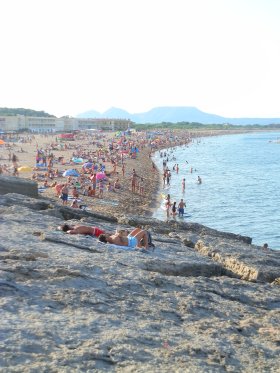 The bay of Isla Roja has no facilities near by, but people like to jump off rocks jutting over the water (about 4-5m high).
The bay of Isla Roja has no facilities near by, but people like to jump off rocks jutting over the water (about 4-5m high).
Sand quality
For Platja Gran the beach is quite broad with dunes at the back. The sand at the top part of the beach is coarse but not stony while at the lower part of the beach near the water the sand feels much finer.
The sand is a type of grey colour rather than the classic sandy yellow.
For the beach of Isla Roja the sand is a little coarser, though still not sandy, and is more of a classic yellow in colour.
Swimming
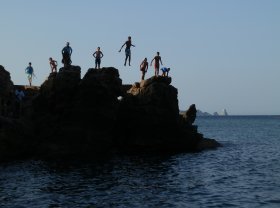 Swimming is as you might expect from a broad long sandy beach with few distinguishing features in the water, but obviously the potential for long uninterrupted swims.
Swimming is as you might expect from a broad long sandy beach with few distinguishing features in the water, but obviously the potential for long uninterrupted swims.
The beach shelves quite quickly and there tends to be a current in the water - a gentle northward drift. If the wind picks up the water can become choppy as it's unsheltered as a bay.
If you like watching fish, we've discovered that around the rocks separating the main beach from Isla Roja beach, there are often large-ish shoals of fish that congregate around the rocks and when the water is clear it can feel like swimming in a fish pond.
Parking
Parking at the height of summer can be tricky particular around the main beach village area.
Parking spaces have to be paid for and there are both parking meters in operation and traffic wardens.
We've found the best place to park is to take the left fork at the Spa roundabout towards the golf clubs and park on one of the roads near the picnic area and tower (masked by the trees if you're looking for it) as it tends to be quieter.
Walks
The GR92 runs past Platja de Pals and it is possible to walk all the way up to Gola de Ter (the mouth of the river Ter). If this is crossable, which it isn't always, you can carry on to L'Estartit.
For us this is a great walk for the winter when the beach is more deserted. The prettier route is to head south and follow the path to the beach at Sa Riera the next beaches along and then possibly up to Begur.
For walks see: Pals beach to Gola de Ter, Masos de Pals, Begur, Sa Riera and Platja de Pals - Regencos to Pals via Quermany Gros and Petit
Next beaches
South to Sa Riera (Begur) - North to Gola del Ter (Pals/L'Estartit)
Swimming and beach at La Fosca
 La Fosca is situated just to the north of Palamos on the Costa Brava.
La Fosca is situated just to the north of Palamos on the Costa Brava.
The beach is large formed by two crescents of some of the softest sand with a rocky outcrop in the centre.
The right half as you look out to sea is backed by houses and a number of modernista buildings.
The left half further round has a selection of seasonal shops and restaurants.
Above the left hand side is the ruin of Castell d'Esteve. Behind the beach are a number of small low-rise hotels and a number of larger campsites including Kings and Palamos International.
The beach is popular with families and young children. The quality of the sand and the space available means it also attracts regular volleyball players who put up nets in the evenings.
La Fosca also very popular with the French. Most days there are regular boules/pentaque games being played just next to the shop area.
The neighbouring beach below the other side of the castle is pebbly, but attracts divers and snorkellers looking to explore the underwater terrain on the far side of the castle.
Facilities at the beaches
The beach includes a large bay which is marked off for swimming.
The rocky area to the right has a number of small boat slipways and is sometimes used as a boat access and is the only place where boats might get close to swimmers.
The right side of the beach (looking out to sea) has pedalo hire with slides and normally there are several pedalos out in the bay.
The left hand side has a canoe rental area. For such a beautiful beach, there aren't so many bars or restaurants.
There are a couple of chiringuitos (bars actually on the beach itself), but mostly the area is surrounded by low rise houses and flats for rent.
Sand quality
 The sand is very fine - probably the softest on the Costa Brava and is perfect for bucket and spade or sand castle making. Even in the rocky extremes to the left and right, there is sand under foot.
The sand is very fine - probably the softest on the Costa Brava and is perfect for bucket and spade or sand castle making. Even in the rocky extremes to the left and right, there is sand under foot.
Swimming
La Fosca has the gentlest entry into the water. It is possible to walk out 30-40m and still touch the bottom. This gentle shelving means that the water has the warmest water.
Early in the season at the start of June, La Fosca will be the first beach that many people choose to go to because of the temperature of the water.
However, there is a downside. Because of the warmth of the water, the bay can turn green and cloudy because it encourages the growth of a harmless algae in the water (if it was France, they'd probably sell it as a beauty treatment). This happens at the hottest periods and has the effect of discouraging many swimmers. In practice the algae is little more than a cloud that accumulates around the central rocky outcrop.
It is possible to swim out beyond the cloud and find clearer water further out.
The bay itself is sandy with some fish, but relatively plain. There are rocky areas to the left and right where you will find more fish and if snorkelling or diving are important, the area on the far side of the ruined castle is deep and clear with lots of nooks and crannies. Just be careful as out here the water is more open and less sheltered than in the bay.
Parking
Parking can be difficult partly because of the need to navigate the one-way streets.
There is parking under the pine trees a little way away, or near to the tennis courts at the back, but it's rare to find a park place right down by the beach at the heart of the summer.
If you have a canoe, you can drop the canoe off close to the beach, then drive off to park.
Walks
The GR92 runs past La Fosca. South is Palamos, but more interesting is the northern walk around the headlands past tucked away fishermen retreats to Platja de Castell.
For walks see: Platja de Castell and La Fosca, La Fosca to Palamos
Next beaches
South to Palamos main beach - North to Platja de Castell
Swimming at the beaches of Calella de Palafrugell
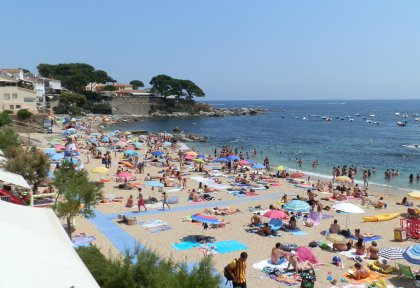 Calella de Palafrugell is one of the Costa Brava's gems. It's a small town on the coast with whitewashed houses, good restaurants and completely unspoilt by high rises or tacky tourism. The town runs along the coast over a series of small bays and coves. As a result there isn't a single town beach, but several different beaches nestling in among the low cliffs and rocky rises. Traditional Calella de Palafrugell was a small fishing village and it still has fishing boats on the beach or out into the water. The town is very picturesque, but it also looks out to the headland of Cap Roig and the islands of the Formigues site of a Catalan naval battle in 1281. There are four beach areas each of them is relatively small so they can get crowded. The first beach from the direction of Llafranc is Platja Canadell. The main (smallest) beach in the centre of town is Port Bo. This is the site of the main Havaneres festival (sea shanties) in July. South from the town are the two beaches of Port Pelegri - the beaches share the same bay, but divided by rocks. Further south before Cap Roig is the pebbly beach at Golfet. Calella de Palafrugell is also an easy walk to Llafranc.
Calella de Palafrugell is one of the Costa Brava's gems. It's a small town on the coast with whitewashed houses, good restaurants and completely unspoilt by high rises or tacky tourism. The town runs along the coast over a series of small bays and coves. As a result there isn't a single town beach, but several different beaches nestling in among the low cliffs and rocky rises. Traditional Calella de Palafrugell was a small fishing village and it still has fishing boats on the beach or out into the water. The town is very picturesque, but it also looks out to the headland of Cap Roig and the islands of the Formigues site of a Catalan naval battle in 1281. There are four beach areas each of them is relatively small so they can get crowded. The first beach from the direction of Llafranc is Platja Canadell. The main (smallest) beach in the centre of town is Port Bo. This is the site of the main Havaneres festival (sea shanties) in July. South from the town are the two beaches of Port Pelegri - the beaches share the same bay, but divided by rocks. Further south before Cap Roig is the pebbly beach at Golfet. Calella de Palafrugell is also an easy walk to Llafranc.
Facilities at the beaches
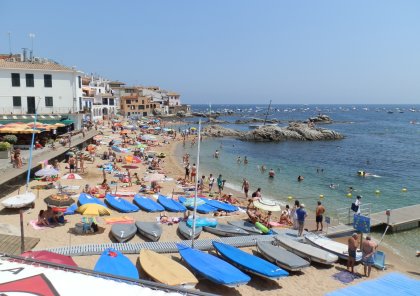 Canadell is the largest of the beaches (though still relatively small). It sits under a promenade with a number of old traditional Indianer houses. On the promenade itself above the beach are a number of bars and resturants and at the left hand end looking out to sea is the Hotel de la Torre, site of the historic watchtower for Calella. Under the promenade are a number of beach huts, some of which have been converted into bars. The beach has a boat taxi service out to the numerous boats that moor at Calella. The beach has lifeguards and it is possible to rent canoes.
Canadell is the largest of the beaches (though still relatively small). It sits under a promenade with a number of old traditional Indianer houses. On the promenade itself above the beach are a number of bars and resturants and at the left hand end looking out to sea is the Hotel de la Torre, site of the historic watchtower for Calella. Under the promenade are a number of beach huts, some of which have been converted into bars. The beach has a boat taxi service out to the numerous boats that moor at Calella. The beach has lifeguards and it is possible to rent canoes.
Port Bo is the smallest of the beaches, but the most central. Bars and restaurants practically fall onto the beach and there is a raised wooden walk way where you pass so close to the people eating that you could pick at the plates. This beach is used by the fishing boats and has a number of rocky outcrops that are readily used as scramble and play areas. It's less used for swimming than the other beaches.
Port Pelegri splits in two and to reach both sides you have to take the path and steps from the promenade just in front of Hotel Mediterrani. The other hotel over looking the beach is Hotel Sant Roc which has private steps down to the sea. At sea level the beaches have houses/huts cut into the rocks and these have typically been turned into beach-side bars and restaurants now but without spoiling the charm of the beach. There are lifeguards and showers at beach level.
Golfet is the furthest beach from the town centre and is practically a wild beach. You can reach it via the Cami de Ronda that runs around the bays through a series of tunnels cut into the rocks, or from the top via steps (there is parking higher up). The beach itself is pebbly and unspoilt, but in some ways this is it's main charm - it's not touristy and has a very natural setting with a pillar of rock to the left and cliffs above. The bay is sandy initially then rocky which make it easy to enter the water.
All the bays are marked off with buoys for swimming.
Sand quality
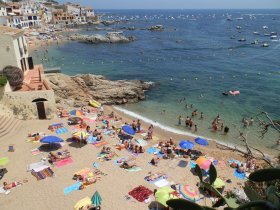 The sand is generally coarse with the exception of Golfet which is made up of pebbles. The bays themselves are rocky but there is a run of sand before the rocks so getting in the water you can wade without a rocky surface. The exception is Canadell where the rocky part of the bay comes quite quickly in some places which can make the transition from warm on the beach to cool in the water difficult on the feet. Here, the best place to enter the water to start with is just in front of canoe area as the sand extends further into the bay.
The sand is generally coarse with the exception of Golfet which is made up of pebbles. The bays themselves are rocky but there is a run of sand before the rocks so getting in the water you can wade without a rocky surface. The exception is Canadell where the rocky part of the bay comes quite quickly in some places which can make the transition from warm on the beach to cool in the water difficult on the feet. Here, the best place to enter the water to start with is just in front of canoe area as the sand extends further into the bay.
Swimming
Swimming is excellent particularly if you like to see fish. The beaches slope quickly into the water and the bays are rocky when you are in the water - hence the number of fish. Being quite sheltered, the water is rarely wavy and typically smooth and clear. In certain bays the rocks in the bay get quite close to the surface, so it's advisable to wear goggles. Stopping in the middle of the bay to admire the view, in some places you can find your feet kicking rocks.
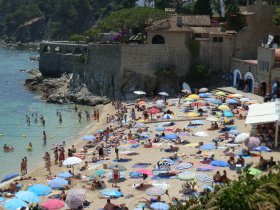 Canadell is long enough to allow for a good distance swim and 'laps', but Port Pelegri has the longest stretch of water once you get out to the buoys.
Canadell is long enough to allow for a good distance swim and 'laps', but Port Pelegri has the longest stretch of water once you get out to the buoys.
Do watch out for the boat markings and if you do decide to cross a channel (eg to make a longer swim) keep an eye out for the boats. Calella is popular with sailors, so there are several channels for the sea-taxis ferrying people in and out of the town and these tend to be quite busy.
Parking
Parking in Calella can be difficult at peak times. There is a pay-for multistory just above the town centre which tends to be quiet as most people try to park on the main connecting road above the beaches. The chances are that you will find a space, but you may need to walk a little to reach the sea.
Walks
The GR92 runs past Calella de Palafrugell. There is a very easy well walked route around the headland to Llafranc. To the south the GR92 takes you past Cap Roig and out to the wild beaches of the Cap Roig/Castell protected area. There is also good walking inland through Ermedas or to Palafrugall and Mont-ras.
For walks see: Eulogy to the Ruta del Tren Petit (Palafrugell, Palamos, Mont-ras and Vall-llobrega) - Calella de Palafrugell/Cap Roig to Castell - classic wild Costa Brava - Mont-ras to Calella de Palafrugell and Llafranc
Next beaches
South to Cala Estreta and wild beaches to El Crit and Cap Roig - North to Llafranc
Swimming at the beach at Aiguablava
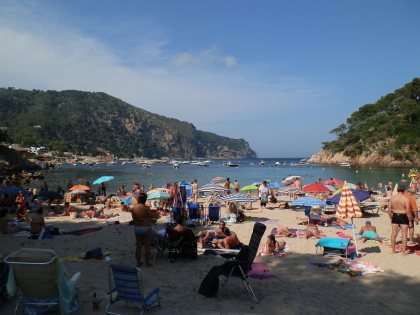 Aiguablava is a sandy beach located in the municipality of Begur, but just on from Tamariu. The beach is famous in that it is used as the poster-image for this part of the Costa Brava with sheltered clear turquoise sea under the cliffs and soft golden sand beach. The beach itself sits below a Parador (a type of luxury historic hotel run by the Spanish government), with rocky inlets to the left as you look out to sea and around a couple of these coves you come to Fornells, a tiny but exquisite fisherman's village with two hotels. During summer the bays fill up with luxury boats and yachts both for the scenery, the sheltered harbour and the quality of the swimming and water. One of the best features is the view across to the headland of Begur. As a result Aiguablava can get very popular (and crowded) at the height of summer. Almost the only way to reach the bay is by car which can make parking tricky.
Aiguablava is a sandy beach located in the municipality of Begur, but just on from Tamariu. The beach is famous in that it is used as the poster-image for this part of the Costa Brava with sheltered clear turquoise sea under the cliffs and soft golden sand beach. The beach itself sits below a Parador (a type of luxury historic hotel run by the Spanish government), with rocky inlets to the left as you look out to sea and around a couple of these coves you come to Fornells, a tiny but exquisite fisherman's village with two hotels. During summer the bays fill up with luxury boats and yachts both for the scenery, the sheltered harbour and the quality of the swimming and water. One of the best features is the view across to the headland of Begur. As a result Aiguablava can get very popular (and crowded) at the height of summer. Almost the only way to reach the bay is by car which can make parking tricky.
Facilities at the beach
The beach does not have a village as such around it. Instead there is just a car park, then as you get down towards the sand there are a small number of seasonal bars and restaurants right on the beach some of which are only accessible across the sand. The bay is marked off for swimming and there is a lifeguard service. However, one of the attractions is that it's easy for experienced swimmers to swim into the other bays or even all the way round to Fornells.
There is a canoe and pedalo hire station to the right hand side. The area would be excellent for canoeing around the bays and cliffs.
Sand quality
The beach itself has a fine sand which is soft between the toes. It would be perfect for making sand castles, but it can get busy and tightly packed during the peak season. The neighbouring bay to the left, reachable walking over the cliff to the left, is an entirely pebble beach. The bays near Fornells are sandy but tiny with barely enough space for more than 2 or 3 families. Platja Fondo further round will be covered later.
Swimming
Swimming is wonderful, though the water can get cloudy when the beach is really busy. For children the main beach shelves gently into the water and is mainly a clear sandy bottom, though the centre part has a line of pebbles just as you enter the water (the extreme left and right are softer). The exception are the rocky areas to either side with boulders and giant stones in the water teeming with fish. As mentioned, for a good swimmer there should be no problem swimming all the way across to Fornells. Each of the small bays is relatively rocky below the surface and there is excellent visibility for shoals of fish or other aquatic life. The only slight downside is that you have swim outside the protected area and among the boats. But mostly they are stationary and there shouldn't be any problem - certainly many people swim directly from the boats.
If Fornells is too far, then there is also good snorkelling in the area to the right and some caves in the rocks that are only accessible from the water.
Parking
Parking can be difficult during the height of summer. The car park directly at the back has parking meters so you will have to pay (and a theoretical maximum time limit so you might need to re-ticket the car). In these sorts of places in the height of summer you can be pretty much guaranteed there will be ticket wardens around. Unfortunately the car park does fill up, and many people park on the road at the top, but again space can be limited. For this reason getting there either early-ish in the morning, or alternatively later in the evening are recommended.
Walks
The GR92 runs past Aiguablava and the walk up the cliff to the left will take you right round to Fornells and ultimately onwards and upwards to Begur. In the other direction the GR92 runs away from the coast to Tamariu - it's a relatively steep climb though.
For walks see: Fornells and Aiguablava walk (GR92) or alternatively Begur, Ses Negres and Sa Riera - Sa Tuna, Cap de Begur, Begur - Palafrugell, Tamariu, Begur residential and Esclanya - Masos de Pals, Begur, Sa Riera and Platja de Pals
Next beaches
South to Aigua Xelida - North to Platja Fonda (Begur)
Swimming at the beach at Tamariu
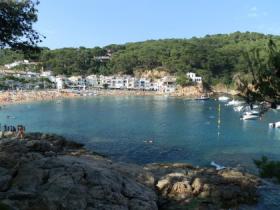 Tamariu is a small fishing village set in a dell with hills to all sides. Officially it's part of the municipality of Palafrugell with the main town of Palafrugell approximately 3-4km away. There are two beaches - the main beach, and a second much smaller pebble beach to the left as you look at the sea. The bay is hemmed in by two rocky headlands. To the left it is quite steep, but to the right you can follow a footpath around the headland to Cala Pedrosa - a wild beach. In the hills behind and around the village are numerous villas and houses. It's a popular resort with French and Dutch holidaymakers. The village centre is quite small so there isn't so much to see, but it is quite picturesque. In summer Tamariu opens up and there are a selection of bars and restaurants on the sea front around the bay It has a seasonal supermarket and clothes/gift shops.At the back of the village is Camping Tamariu in a quiet valley location.
Tamariu is a small fishing village set in a dell with hills to all sides. Officially it's part of the municipality of Palafrugell with the main town of Palafrugell approximately 3-4km away. There are two beaches - the main beach, and a second much smaller pebble beach to the left as you look at the sea. The bay is hemmed in by two rocky headlands. To the left it is quite steep, but to the right you can follow a footpath around the headland to Cala Pedrosa - a wild beach. In the hills behind and around the village are numerous villas and houses. It's a popular resort with French and Dutch holidaymakers. The village centre is quite small so there isn't so much to see, but it is quite picturesque. In summer Tamariu opens up and there are a selection of bars and restaurants on the sea front around the bay It has a seasonal supermarket and clothes/gift shops.At the back of the village is Camping Tamariu in a quiet valley location.
Facilities at the beach
The bay is marked off for swimming with boats mooring outside this line and a boat-taxi service out to the boats. The bay is compact - it's easy to swim from one side to the other. During summer there is a lifeguard service and there are practical things like toilets and fresh water showers. It is possible to hire canoes and there is a scuba diving place at the beach.
Sand quality
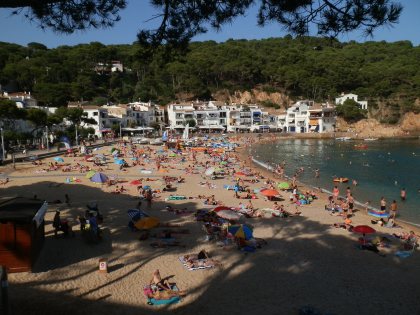 The main beach is a mix of coarse grit-type sand with small pebbles in places, in other places the sand is a little finer. Sunbathers have three quarters of the beach, the last part is reserved for fishing boats. The main beach has a small rocky outcrop to one side. The area to the right of the outcrop is generally quieter and more private. In the evening this quieter part loses the sun first.
The main beach is a mix of coarse grit-type sand with small pebbles in places, in other places the sand is a little finer. Sunbathers have three quarters of the beach, the last part is reserved for fishing boats. The main beach has a small rocky outcrop to one side. The area to the right of the outcrop is generally quieter and more private. In the evening this quieter part loses the sun first.
The quieter pebble bay to the left is all pebble and hard on barefeet. Best with shoes or flipflops on. The people using this bay tend to be snorkellers and swimmers as it fabulous for seeing fish.
Swimming
From the main beach, there is a layer of pebbles as you enter the water. The beach then shelves away steeply so you are quickly out of your depth. The main bay area has a sandy bottom all the way out to the buoys which means there aren't so many fish so swimming is mainly just swimming.
Around to the right, out towards the headland there is a diving board off the rocks about 2m above the water level. This has always been a splash with children. This rockier area is also better for wildlife.
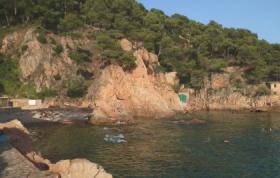 The pebble bay to the left has a rocky bay. It shelves gently, though this is tough on the feet as it's rocks all the way in. A better bet is to jump in from the side. The water here is normally crystal clear and there are usually shoals of fish in the bay. You can also swim around to an otherwise inaccessible bay.
The pebble bay to the left has a rocky bay. It shelves gently, though this is tough on the feet as it's rocks all the way in. A better bet is to jump in from the side. The water here is normally crystal clear and there are usually shoals of fish in the bay. You can also swim around to an otherwise inaccessible bay.
Canoeing
Canoes can be rented from the beach and there is excellent canoeing particularly as you get around to Aigua Xelida and then on to Aiguablava and Fornells. The bays immediately after Aigua Xelida beach have rocks and cliffs with narrow canyon type inlets and crystal clear water sheltered from the wind and waves of the sea and almost inaccessible other than on the water.
Parking
Parking can be difficult during the height of summer. There are two smallish car parks along the main street through the valley. Alternatively road parking can normally be found on the road out towards Aiguablava/Begur - though it can mean a few minutes walk to get to the beach.
Walks
The GR92 runs through Tamariu. You can follow the path around the headland to the right through one wild beach and up to the lighthouse above Llafranc (San Sebastien).
For walks see: Far de Sant Sebastia (Llafranc) to Tamariu - Palafrugell, Tamariu, Begur residential and Esclanya
Next beaches
South to Llafranc - North to Aigua Xelida
Comments | ||
adam@veggingoutwithadam.com |
17 Feb 2014 19:46 |
|
What a great blog. I am planning a walking holiday in the region and wonder if you can recommend the best walking maps, like UK ordnance survey ones. I shall be reading more of your walks over the coming days as we plan. Many thanks Adam | ||
Saul |
24 Feb 2014 17:25 |
|
Glad you're enjoying it. We have recommendations for maps in our 'Advice and FAQ' section | ||
Saul |
13 Jul 2017 12:46 |
|
Sorry I missed the comment, so I hope it's not too late - use the contact box if you'd like to send a message. For the coast, the GR92 is best and if you have driver you can just take it piece by piece. For hikers, around Cap de Creus is great, though it can be dry and hard walking in summer. For us, the stretch between Palamos and Palafrugell and on to Begur is the prettiest part of the whole Costa Brava and really good for walking. I'd probably also take the walk up and over Montgri, possibly starting at Pals, or L'Estartit to L'Escala. And though you said you prefer the coast, don't overlook inland routes as there are some wonderful villages and countryside out towards Girona, La Bisbal, or Olot. | ||
Sven-Gunnar Furmark |
24 May 2017 11:43 |
|
Hi, My name is Sven Furmark. I am from Sweden. I plan to go to Costa Brava with some friends (totally about 10 people) for hiking for one week (5 walking days). We are experienced hikers and we usually walk 4-6 hours per day. We prefer to walk along the coast as much as possible. We plan to rent a house and travel to each days hiking with a bus & driver which we plan to book for the whole week. Which five hikes would you recommend for us. Warm Regards Sven | ||

